Computer Access Technology MRLN-A128 Bluetooth Protocol Analyzer User Manual 01 Merlin
Computer Access Technology Corporation Bluetooth Protocol Analyzer 01 Merlin
Contents
- 1. Manual Part 1
- 2. Manual Part 2
Manual Part 1
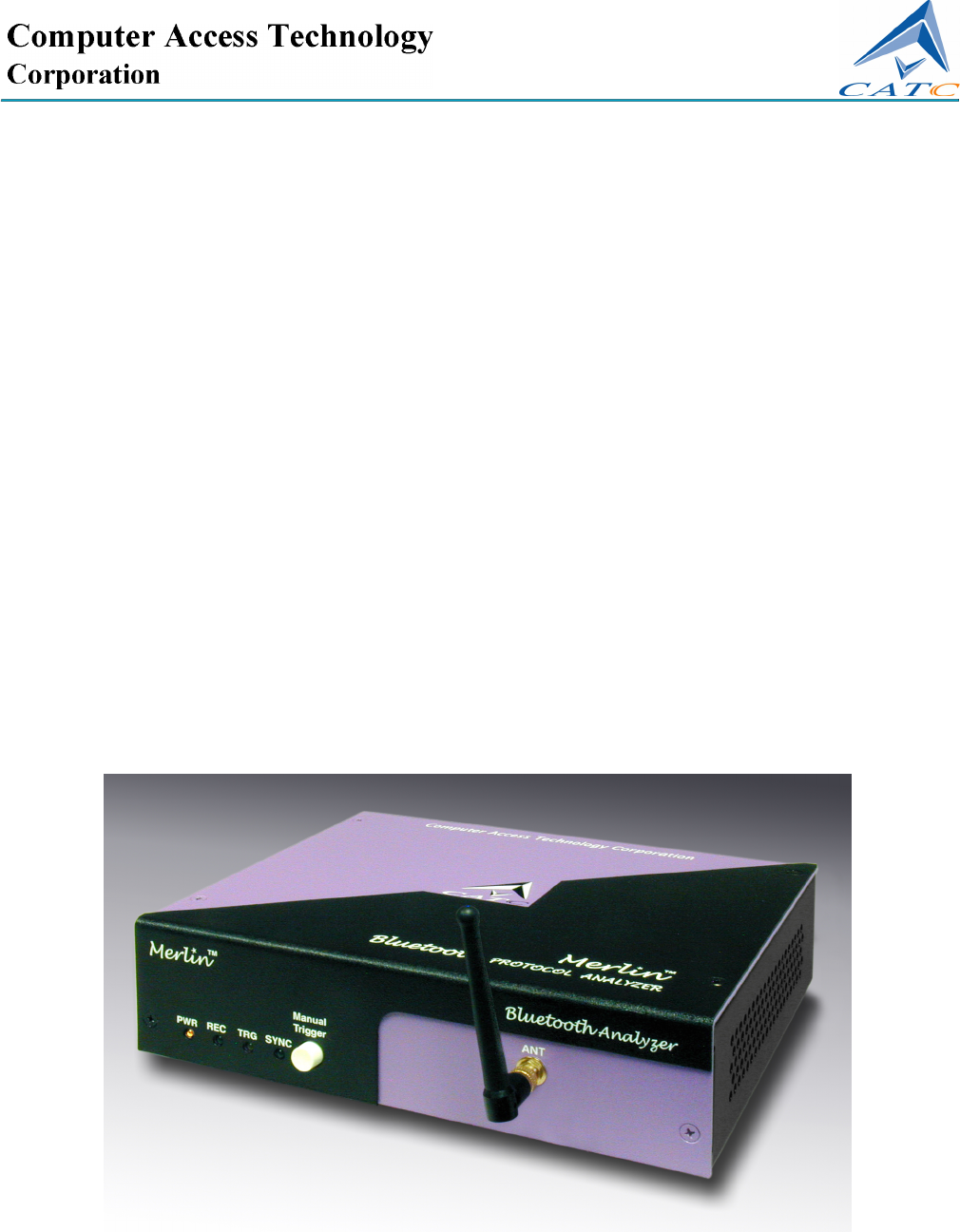
2403 Walsh Avenue, Santa Clara, CA 95051-1302 Tel: +1/408.727.6600 Fax: +1/408.727.6622
Version 1.6
8 June, 2001
CATC Merlin™
Bluetooth™ Protocol Analyzer
User’s Manual

ii
Merlin Protocol Analyzer User’s ManualCATC Version 1.6
Document Disclaimer
The information contained in this document has been carefully checked and
is believed to be reliable. However, no responsibility can be assumed for
inaccuracies that may not have been detected.
CATC reserves the right to revise the information presented in this
document without notice or penalty.
Trademarks and Servicemarks
CATC, Merlin, NetMate, Advisor, Chief, FireInspector, Inspector,
Detective, Traffic Generator, BusEngine, USB4DOS, UPT, HPT, UHT,
Galaxy, and Andromeda are trademarks of Computer Access Technology
Corporation.
Microsoft, Windows, and Windows NT are registered trademarks of
Microsoft Inc.
All other trademarks are property of their respective companies.
Copyright
Copyright © 2001, Computer Access Technology Corporation (CATC); All
Rights Reserved.
This document may be printed and reproduced without additional
permission, but all copies should contain this copyright notice.
Part number: 730-0017-00

iii
Merlin Protocol Analyzer User’s ManualCATC Version 1.6
TABLE OF CONTENTS
Chapter 1 Overview. . . . . . . . . . . . . . . . . . . . . . . . . . . . . . . . . . . . . 1
Bluetooth™ Overview . . . . . . . . . . . . . . . . . . . . . . . . . . . . . . . 1
General Description . . . . . . . . . . . . . . . . . . . . . . . . . . . . . . . . . 2
Features. . . . . . . . . . . . . . . . . . . . . . . . . . . . . . . . . . . . . . . . . . . 4
General . . . . . . . . . . . . . . . . . . . . . . . . . . . . . . . . . . . . . . . . 4
Physical Components . . . . . . . . . . . . . . . . . . . . . . . . . . . . . 4
Display Options . . . . . . . . . . . . . . . . . . . . . . . . . . . . . . . . . 5
Recording Options . . . . . . . . . . . . . . . . . . . . . . . . . . . . . . . 5
Traffic Generation. . . . . . . . . . . . . . . . . . . . . . . . . . . . . . . . 5
Bluetooth™ BusEngine . . . . . . . . . . . . . . . . . . . . . . . . . . . 5
Specifications . . . . . . . . . . . . . . . . . . . . . . . . . . . . . . . . . . . . . . 6
Package . . . . . . . . . . . . . . . . . . . . . . . . . . . . . . . . . . . . . . . . 6
Power Requirements . . . . . . . . . . . . . . . . . . . . . . . . . . . . . . 6
Environmental Conditions . . . . . . . . . . . . . . . . . . . . . . . . . 6
Switches . . . . . . . . . . . . . . . . . . . . . . . . . . . . . . . . . . . . . . . 6
LEDs . . . . . . . . . . . . . . . . . . . . . . . . . . . . . . . . . . . . . . . . . 6
Recording Memory Size . . . . . . . . . . . . . . . . . . . . . . . . . . . 6
Certification . . . . . . . . . . . . . . . . . . . . . . . . . . . . . . . . . . . . 6
Chapter 2 Quick Installation . . . . . . . . . . . . . . . . . . . . . . . . . . . . . 7
Setting Up the Analyzer . . . . . . . . . . . . . . . . . . . . . . . . . . . . . . 7
Installing the Software . . . . . . . . . . . . . . . . . . . . . . . . . . . . . . . 7
Your First Bluetooth™ Recording . . . . . . . . . . . . . . . . . . . . . . 8
Chapter 3 Detailed Installation . . . . . . . . . . . . . . . . . . . . . . . . . . 11
System Components/Packing List . . . . . . . . . . . . . . . . . . . . . 11
The Installed Merlin Unit . . . . . . . . . . . . . . . . . . . . . . . . . . . . 11
Merlin System Setup. . . . . . . . . . . . . . . . . . . . . . . . . . . . . . . . 12
AC Power Source . . . . . . . . . . . . . . . . . . . . . . . . . . . . . . . . . . 12
External Interface Breakout Board . . . . . . . . . . . . . . . . . . . . . 13
Breakout Board External Output Signalling Pins . . . . . . . 14
Prototype Rework Area . . . . . . . . . . . . . . . . . . . . . . . . . . 15
PC Connection . . . . . . . . . . . . . . . . . . . . . . . . . . . . . . . . . . . . 15
Antenna Information. . . . . . . . . . . . . . . . . . . . . . . . . . . . . . . . 15
Analyzer PC Requirements. . . . . . . . . . . . . . . . . . . . . . . . . . . 15
Merlin Program Installation . . . . . . . . . . . . . . . . . . . . . . . . . . 16
Loading the Merlin USB Drivers . . . . . . . . . . . . . . . . . . . 16
Installing the Merlin Application Program. . . . . . . . . . . . 16
Merlin Program Startup . . . . . . . . . . . . . . . . . . . . . . . . . . . . . 17
Making a Recording . . . . . . . . . . . . . . . . . . . . . . . . . . . . . . . . 18
Chapter 4 Upgrades. . . . . . . . . . . . . . . . . . . . . . . . . . . . . . . . . . . . 19

iv
Merlin Protocol Analyzer User’s ManualCATC Version 1.6
Software, Firmware, and BusEngine Revisions . . . . . . . . . . . 19
Software Upgrades . . . . . . . . . . . . . . . . . . . . . . . . . . . . . . . . . 20
BusEngine and Firmware Upgrades . . . . . . . . . . . . . . . . . . . . 20
Automatic Upgrades . . . . . . . . . . . . . . . . . . . . . . . . . . . . . 20
Manual Upgrades to BusEngine and Firmware . . . . . . . . 22
Upgrading the BusEngine. . . . . . . . . . . . . . . . . . . . . . . . . 22
Upgrading the Firmware. . . . . . . . . . . . . . . . . . . . . . . . . . 24
Chapter 5 Software Overview . . . . . . . . . . . . . . . . . . . . . . . . . . . 25
The Main Display Windows . . . . . . . . . . . . . . . . . . . . . . . . . . 25
View Options . . . . . . . . . . . . . . . . . . . . . . . . . . . . . . . . . . . . . 27
Tool Bar . . . . . . . . . . . . . . . . . . . . . . . . . . . . . . . . . . . . . . 27
Status Bar . . . . . . . . . . . . . . . . . . . . . . . . . . . . . . . . . . . . . . . . 29
Recording Progress . . . . . . . . . . . . . . . . . . . . . . . . . . . . . . 29
Recording Status . . . . . . . . . . . . . . . . . . . . . . . . . . . . . . . . 30
Analyzer Status . . . . . . . . . . . . . . . . . . . . . . . . . . . . . . . . . 30
Search Status. . . . . . . . . . . . . . . . . . . . . . . . . . . . . . . . . . . 31
Zoom In. . . . . . . . . . . . . . . . . . . . . . . . . . . . . . . . . . . . . . . 31
Zoom Out . . . . . . . . . . . . . . . . . . . . . . . . . . . . . . . . . . . . . 31
Tool Tips . . . . . . . . . . . . . . . . . . . . . . . . . . . . . . . . . . . . . . . . . 31
Merlin Analyzer Keyboard Shortcuts . . . . . . . . . . . . . . . . . . . 32
Chapter 6 Recording Wizard . . . . . . . . . . . . . . . . . . . . . . . . . . . . 33
Starting Recording Wizard . . . . . . . . . . . . . . . . . . . . . . . . 33
Recording a Traffic on a New Piconet . . . . . . . . . . . . . . . . . . 34
Recording an Existing Piconet . . . . . . . . . . . . . . . . . . . . . . . . 45
Recording in Test Mode . . . . . . . . . . . . . . . . . . . . . . . . . . . . . 55
Recording in Reduced Hopping Mode . . . . . . . . . . . . . . . 55
Chapter 7 Recording Options. . . . . . . . . . . . . . . . . . . . . . . . . . . . 59
Opening the Recording Options Dialog Box . . . . . . . . . . 59
Recording Options - General . . . . . . . . . . . . . . . . . . . . . . . . . 60
Recording type . . . . . . . . . . . . . . . . . . . . . . . . . . . . . . . . . 60
Options . . . . . . . . . . . . . . . . . . . . . . . . . . . . . . . . . . . . . . . 61
Buffer Size . . . . . . . . . . . . . . . . . . . . . . . . . . . . . . . . . . . . 61
Trigger Position . . . . . . . . . . . . . . . . . . . . . . . . . . . . . . . . 61
Recording Options - Modes . . . . . . . . . . . . . . . . . . . . . . . . . . 62
Recording Mode . . . . . . . . . . . . . . . . . . . . . . . . . . . . . . . . 63
Inquiry Recording . . . . . . . . . . . . . . . . . . . . . . . . . . . . . . . 63
Piconet Recording. . . . . . . . . . . . . . . . . . . . . . . . . . . . . . . 63
Hop Frequency . . . . . . . . . . . . . . . . . . . . . . . . . . . . . . . . . 67
Force Re-synchronization . . . . . . . . . . . . . . . . . . . . . . . . . 68
Follow Master/Slave Switch. . . . . . . . . . . . . . . . . . . . . . . 68
Match Clock Rate . . . . . . . . . . . . . . . . . . . . . . . . . . . . . . . 68

v
Merlin Protocol Analyzer User’s ManualCATC Version 1.6
Show Paging Traffic . . . . . . . . . . . . . . . . . . . . . . . . . . . . . 69
Piconet Addresses (MSB -> LSB) . . . . . . . . . . . . . . . . . . 69
Other Parameters. . . . . . . . . . . . . . . . . . . . . . . . . . . . . . . . 69
Debug/Test . . . . . . . . . . . . . . . . . . . . . . . . . . . . . . . . . . . . 70
Recording Options - Events . . . . . . . . . . . . . . . . . . . . . . . . . . 70
Events Options . . . . . . . . . . . . . . . . . . . . . . . . . . . . . . . . . 71
Payload Length Error. . . . . . . . . . . . . . . . . . . . . . . . . . . . 77
Recording Options - Actions . . . . . . . . . . . . . . . . . . . . . . . . . 78
Actions Window Layout . . . . . . . . . . . . . . . . . . . . . . . . . . 78
Action Buttons - Their Functions . . . . . . . . . . . . . . . . . . . 79
Counting Buttons - Their Functions . . . . . . . . . . . . . . . . . 79
Blue Dot Menus . . . . . . . . . . . . . . . . . . . . . . . . . . . . . . . . 81
Saving Recording Options . . . . . . . . . . . . . . . . . . . . . . . . . . . 87
Recording Bluetooth™ Traffic . . . . . . . . . . . . . . . . . . . . . . . . 88
Chapter 8 Display Options . . . . . . . . . . . . . . . . . . . . . . . . . . . . . . 91
General Display Options. . . . . . . . . . . . . . . . . . . . . . . . . . . . . 91
Trace Viewing Level. . . . . . . . . . . . . . . . . . . . . . . . . . . . . 92
Creating New Display Options Files . . . . . . . . . . . . . . . . 92
Color Display Options . . . . . . . . . . . . . . . . . . . . . . . . . . . . . . 93
Formats Display Options . . . . . . . . . . . . . . . . . . . . . . . . . . . . 95
Hiding . . . . . . . . . . . . . . . . . . . . . . . . . . . . . . . . . . . . . . . . . . . 96
Saving Display Options . . . . . . . . . . . . . . . . . . . . . . . . . . . . . 97
Chapter 9 Reading a CATC Trace . . . . . . . . . . . . . . . . . . . . . . . . 99
Trace View Features . . . . . . . . . . . . . . . . . . . . . . . . . . . . . . . . 99
Interpreting the Displayed Information . . . . . . . . . . . . . . . . . 99
Tool Tips . . . . . . . . . . . . . . . . . . . . . . . . . . . . . . . . . . . . . . . . 100
Set Marker. . . . . . . . . . . . . . . . . . . . . . . . . . . . . . . . . . . . . . . 100
Edit or Clear Marker . . . . . . . . . . . . . . . . . . . . . . . . . . . . . . . 101
Expanded and Collapsed Data Formats . . . . . . . . . . . . . . . . 102
Hide Frequency Hops . . . . . . . . . . . . . . . . . . . . . . . . . . . . . . 103
Hide Nulls and Polls . . . . . . . . . . . . . . . . . . . . . . . . . . . . . . . 103
Hide Unassociated Traffic . . . . . . . . . . . . . . . . . . . . . . . . . . 104
Chapter 10 Decoding Higher Protocols . . . . . . . . . . . . . . . . . . . . 105
Introduction. . . . . . . . . . . . . . . . . . . . . . . . . . . . . . . . . . . . . . 105
LMP and L2CAP Messages . . . . . . . . . . . . . . . . . . . . . . . . . 105
Decoding and Viewing Higher Protocol Data . . . . . . . . . . . 106
Decoding Via the Decoding Toolbar. . . . . . . . . . . . . . . . 106
Decoding Via the Display Options Dialog Box . . . . . . . 106
Tooltips . . . . . . . . . . . . . . . . . . . . . . . . . . . . . . . . . . . . . . . . . 107
Viewing Packets in LMP and L2CAP Messages . . . . . . . . . 108
Types of LMP and L2CAP Messages. . . . . . . . . . . . . . . . . . 108

vi
Merlin Protocol Analyzer User’s ManualCATC Version 1.6
Viewing L2CAP Channel Connections . . . . . . . . . . . . . . . . 109
Viewing Protocol Messages and Transactions . . . . . . . . . . . 110
Viewing L2CAP Messages in Protocol Messages . . . . . 110
How to Decode . . . . . . . . . . . . . . . . . . . . . . . . . . . . . . . . 110
Expanding Protocol Messages . . . . . . . . . . . . . . . . . . . . 111
Changing Protocol Assignments. . . . . . . . . . . . . . . . . . . . . . 111
Using the Decoding Assignments Dialog Box . . . . . . . . 112
Removing User-Assigned Protocol Assignments. . . . . . 112
Manually Assigning Protocols . . . . . . . . . . . . . . . . . . . . 113
Other Assignments: OBEX Client/Server Status . . . . . . 113
Changing an OBEX Client or Server Status . . . . . . . . . . 114
Decoding BNEP (Bluetooth Network Encapsulation Protocol)
114
Chapter 11 Other Features . . . . . . . . . . . . . . . . . . . . . . . . . . . . . . 115
Search . . . . . . . . . . . . . . . . . . . . . . . . . . . . . . . . . . . . . . . . . . 115
Go to Trigger. . . . . . . . . . . . . . . . . . . . . . . . . . . . . . . . . . 115
Go to Packet/Message/Protocol . . . . . . . . . . . . . . . . . . . 115
Go to Marker. . . . . . . . . . . . . . . . . . . . . . . . . . . . . . . . . . 116
Go to . . . . . . . . . . . . . . . . . . . . . . . . . . . . . . . . . . . . . . . . 116
Error . . . . . . . . . . . . . . . . . . . . . . . . . . . . . . . . . . . . . . . . 119
Soft Bit Error . . . . . . . . . . . . . . . . . . . . . . . . . . . . . . . . . 119
Loss of Sync . . . . . . . . . . . . . . . . . . . . . . . . . . . . . . . . . . 119
Find . . . . . . . . . . . . . . . . . . . . . . . . . . . . . . . . . . . . . . . . . 120
Event Groups . . . . . . . . . . . . . . . . . . . . . . . . . . . . . . . . . 121
Union, Intersection, and Exclusion. . . . . . . . . . . . . . . . . 124
Using Find. . . . . . . . . . . . . . . . . . . . . . . . . . . . . . . . . . . . 124
Find Next . . . . . . . . . . . . . . . . . . . . . . . . . . . . . . . . . . . . 126
Edit Comment . . . . . . . . . . . . . . . . . . . . . . . . . . . . . . . . . . . . 126
Reports . . . . . . . . . . . . . . . . . . . . . . . . . . . . . . . . . . . . . . . . . 127
File Information . . . . . . . . . . . . . . . . . . . . . . . . . . . . . . . 127
Error Summary . . . . . . . . . . . . . . . . . . . . . . . . . . . . . . . . 127
Timing Calculations . . . . . . . . . . . . . . . . . . . . . . . . . . . . 128
Traffic Summary . . . . . . . . . . . . . . . . . . . . . . . . . . . . . . . 129
BT Neighborhood . . . . . . . . . . . . . . . . . . . . . . . . . . . . . . . . . 131
Encryption. . . . . . . . . . . . . . . . . . . . . . . . . . . . . . . . . . . . . . . 131
Configuring Merlin for Encryption. . . . . . . . . . . . . . . . . 132
Chapter 12 How to Contact CATC . . . . . . . . . . . . . . . . . . . . . . . 135
Chapter 13 Warranty and License. . . . . . . . . . . . . . . . . . . . . . . . 135

1
Merlin Protocol Analyzer User’s ManualCATC Version 1.6
1. Overview
The CATC Merlin™ Protocol Analyzer is the newest member in CATC's
industry-leading line of high performance, serial bus protocol analyzers.
Preceded by CATC’s USB Chief™ and IEEE 1394 FireInspector™
Analyzers, Merlin has been designed using the same modular software and
hardware architecture that made its predecessors highly successful in the
serial bus protocol analyzer market worldwide.
1.1 Bluetooth™ Overview
The Bluetooth™ wireless technology is set to revolutionize the personal
connectivity market by providing freedom from wired connections. It is a
specification for a small-form factor, low-cost radio solution providing links
between mobile computers, mobile phones and other portable handheld
devices, and connectivity to the internet.
The Bluetooth™ Special Interest Group (SIG), comprised of leaders in the
telecommunications, computing, and network industries, is driving
development of the technology and bringing it to market. The Bluetooth™
SIG includes promoter companies 3Com, Ericsson, IBM, Intel, Lucent,
Microsoft, Motorola, Nokia and Toshiba, and more than 2000 SIG
members.
Bluetooth™ is a radio technology specification designed to transmit both
voice and data wirelessly, providing an easier way for a variety of mobile
computing, communications and other devices to communicate with one
another without the need for cables. Bluetooth™ could make possible what
is being called the personal-area network by allowing users to transmit small
amounts of data at 1M bit/sec up to 10 meters over the 2.4-GHz radio
frequency. The key benefits of the Bluetooth™ technology are robustness,
low complexity, low power and low cost. Bluetooth™ employs a rapid
frequency hopping mechanism to minimize the effects of ‘collisions’ with
other protocols and devices operating in the same frequency band.
Mechanisms exist for a Bluetooth™ device to determine all devices in range
as well as to request connection to a piconet as either a master or a slave.
Please refer to the Bluetooth™ Specification, version 1.0b for details on the
protocol. The Bluetooth™ specification is available from the Bluetooth™
SIG at its web site http://www.bluetooth.com/

2
Merlin Protocol Analyzer User’s ManualCATC Version 1.6
1.2 General Description
The Merlin Protocol Analyzer is designed as a stand-alone unit that can be
easily configured and controlled by a portable or desktop PC connected via
its USB port. Merlin provides customers with the familiar ‘CATC Trace’
user interface that is the de facto industry standard for documenting the
performance of high-speed serial protocols.
Merlin supports the functionality required to analyze all levels, including
the baseband, of the Bluetooth™ wireless protocol. The featured Radio
Interface allows users to probe and analyze transactions at the lowest level
within the Bluetooth™ architecture. By creating this "Point of Observation"
or probing point within the radio level packet view, the user can analyze all
levels of the protocol stack.
Merlin is a non-intrusive testing tool for Bluetooth™ piconets providing
network traffic capture and analysis. Hardware triggering allows real-time
events to be captured from a piconet. Hardware filtering allows the filtering
out of fields, packets, and errors from the recording. Filtering allows users
to focus recordings on events of interest and to preserve recording memory
so that the recording time can be extended.
Recorded data is presented in colored graphics in a trace viewer application.
This application has advanced search and viewing capabilities that allow the
user to quickly locate specific data, errors and other desired conditions,
thereby focussing the user’s attention on events of interest.
The Merlin Protocol Analyzer functions with any personal computer using
the Windows 98, Windows 98SE, Windows NT 4.0, or Windows ME
operating systems and equipped with a functional USB interface. The
Analyzer is a stand-alone unit configured and controlled through a personal
computer USB port. It can be used with portable computers for field service
and maintenance as well as with desktop units in a development
environment. It is easily installed by connecting a cable between the
computer’s USB port and the Analyzer’s USB port.
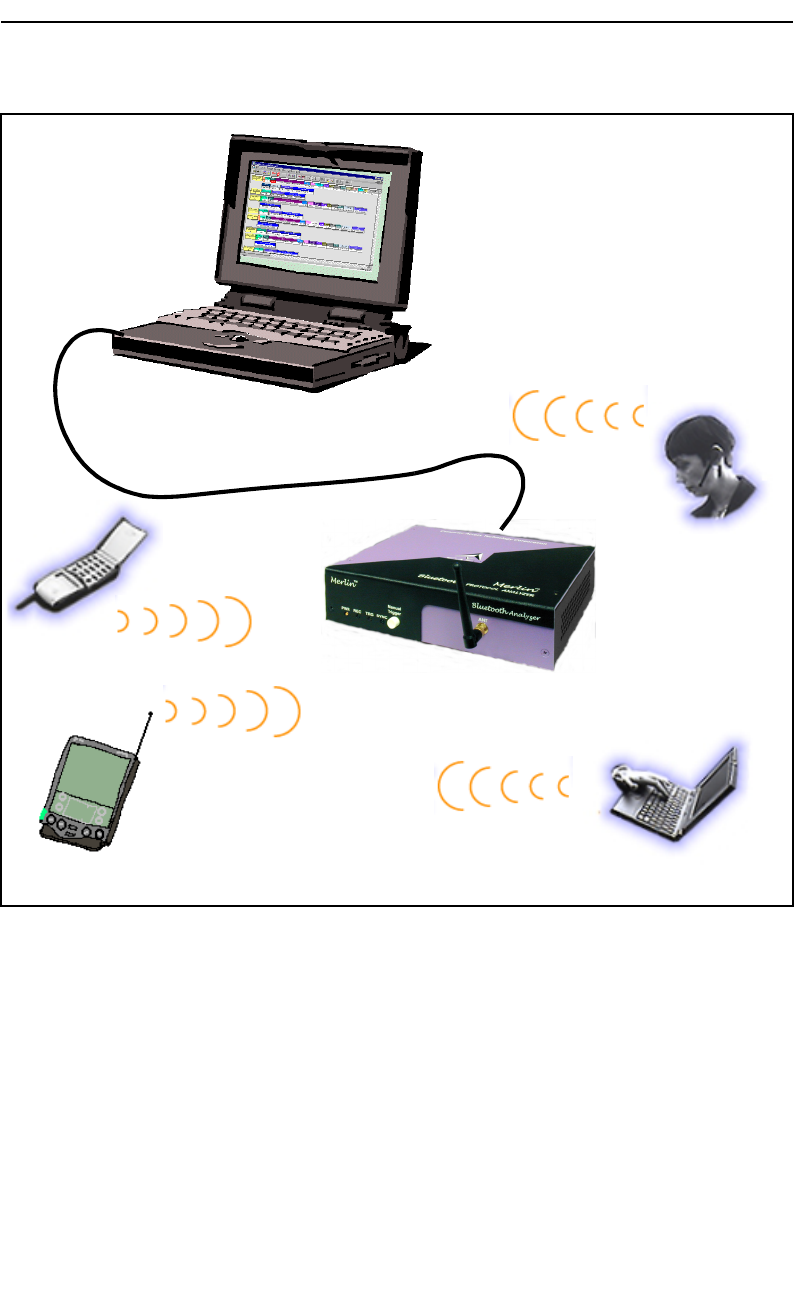
3
Merlin Protocol Analyzer User’s ManualCATC Version 1.6
Sample Bluetooth™ Piconet with Merlin Protocol Analyzer
Merlin provides on-the-fly detection of and triggering on such events as
Packet Headers and Errors. Whether recording manually or with a specified
trigger condition, Merlin continuously records the bus data in a wrap-around
fashion until manually stopped or until the Trigger Event is detected and a
specified post-Trigger amount of bus data is recorded.
Upon detection of a triggering event, the analyzer continues to record data
up to a point specified by the user. Real-time detection of events can be
individually enabled or disabled to allow triggering on events as they
happen. This includes predefined exception or error conditions and a

4
Merlin Protocol Analyzer User’s ManualCATC Version 1.6
user-defined set of trigger events. The unit can also be triggered by an
externally supplied signal. An external DB-9 connector provides a path for
externally supplied data or timing data to be recorded along with bus traffic.
This DB-9 connector also provides a path for Merlin to transmit externally
two control, timing, or recovered signals for purposes of probing and use by
other circuitry.
The Merlin software provides powerful search functions that enable
investigation of particular events and allow the software to identify and
highlight specific events. In addition to immediate analysis, you can print
any part of the data. Use the Save As feature to save the data on disk for later
viewing. The program also provides a variety of timing information and
data analysis reports.
1.3 Features
General
• Flexible design - reconfigurable hardware for future enhancements.
• User friendly - the Graphical User Interface software of Merlin Analyzer
is designed to be consistent with the ‘CATC Trace’ using color and
graphics to display Bluetooth™ traffic.
• Radio Level Point of Observation and Capture - traffic capture at the
Radio Level for comprehensive analysis.
• Complies with Bluetooth™ v1.1 specification.
• Supports point-to-point and point-to-multipoint Bluetooth™ piconets.
• Supports both 79 frequency hop and 23 frequency hop standards.
• Free non-recording, view-only software available.
• Power-on self-diagnostics.
• Internal 100V to 240 V AC power supply.
• Compliant with FCC class A requirements / meets all CE mark
requirements.
• One year warranty and hot-line customer support.
Physical Components
• USB host connection to portable and desktop PCs for analysis of
captured information.
• Host software support for Microsoft Windows 98, Windows 98SE,
Windows ME, and Windows NT 4.0.
• Trace viewer software support for all of the above plus Windows 95.

5
Merlin Protocol Analyzer User’s ManualCATC Version 1.6
• Recording memory of 128MB - enough to record twenty five minutes of
high volume traffic.
Display Options
• Analyzes and displays a transaction-level view of piconet traffic with
accurate time-stamps and frequency hop information.
• Software analysis and data presentation at several protocol levels:
(Baseband, LMP, L2CAP, SDP, RFCOMM, TCS, OBEX, HDLC,
BNEP, PPP, and AT Commands).
Recording Options
• Flexible advanced triggering capabilities including - multiple triggering
modes, selective views, timing analysis, search functions, protocol
packet errors, transaction errors, packet type and destination device, data
patterns, or any of these trigger types in combination.
• User defined trigger position.
• Real-time hardware filtering of captured traffic for optimizing analyzer
memory usage.
Traffic Generation
• Traffic generation capability (when used in future add-on product).
Bluetooth™ BusEngine
CATC’s BusEngine™ Technology is at the heart of the new Merlin
Analyzer. The revolutionary BusEngine core uses state-of-the-art EPLD
technology and incorporates both the real-time recording engine and the
configureable building blocks that implement data/state/error detection,
triggering, capture filtering, external signal monitoring and event counting
& sequencing. And like the flash-memory-based firmware that controls its
operation, all BusEngine logic is fully field upgradeable, using
configuration files that can be downloaded from the CATC Website.

6
Merlin Protocol Analyzer User’s ManualCATC Version 1.6
1.4 Specifications
Package
Power Requirements
90-264VAC, 47-63Hz (universal input), 100W maximum
Environmental Conditions
Switches
LEDs
Recording Memory Size
128M x 8-bit DRAM for traffic data capture, timing, state and other data.
Certification
FCC (Class A), CE Mark, CSA
Dimensions: 9.2 x 8.4 x 2.5 inches
(23.4 x 21.3 x 6.4 cm)
Connectors: AC power connection
external clock input (EXT CLK, BNC)
host connection (USB, type ‘B’)
data connector (Data In/Out, 9-pin DB)
Weight: 2.8 lbs. (1.2 kg)
Operating Range: 0 to 55 °C (32 to 131 °F)
Storage Range: -20 to 80 °C (-4 to 176 °F)
Humidity: 10 to 90%, non-condensing
Power: on/off
Manual Trigger: when pressed forces a trigger event
Power (PWR): illuminated when the analyzer is powered on.
Recording (REC): illuminated when the analyzer is actively recording traffic
data.
Triggered (TRG): illuminated during power-on testing, and when the analyzer
has detected a valid trigger condition.
Synchronized
(SYNC):
flashes during acquisition of the traffic hop sequence, illu-
minated when the analyzer is locked to the hop sequence.

7
Merlin Protocol Analyzer User’s ManualCATC Version 1.6
2. Quick Installation
The Merlin Protocol Analyzer components and software are easily installed
and quickly ready to run on most Windows-based personal computer
systems. You can begin making Bluetooth™ recordings after following
these initial steps. However, if you are new to personal computers and
protocol analyzers, or if you are unsure about what to do after reading the
Quick Installation instructions, or if your analyzer does not work after you
follow these instructions, read through the subsequent sections in this
manual.
2.1 Setting Up the Analyzer
Step 1 Attach the Antenna to the ANT connection point. The
antenna should point up.
Step 2 Connect the AC power cable to the rear of the analyzer.
Step 3 Turn on the power switch on the rear of the analyzer.
Step 4 Insert the first Merlin diskette (Disk 1 of 2) into your
analyzing PC floppy disk drive.
Step 5 Connect the USB cable between the USB port on the back of
the analyzer and a USB port on the analyzing PC.
Step 6 Follow Windows on-screen Plug-and-Play instructions for
the automatic installation of the Merlin Analyzer as a USB
device on your analyzing PC (the first Merlin diskette
includes the required USB files).
2.2 Installing the Software
Step 1 Run the program a:\setup and follow the on-screen
instructions to install the Merlin application on the analyzing
PC hard disk.
Step 2 To start the application, launch the CATC Merlin program
from the Start Menu: Start>Programs>CATC>Merlin.
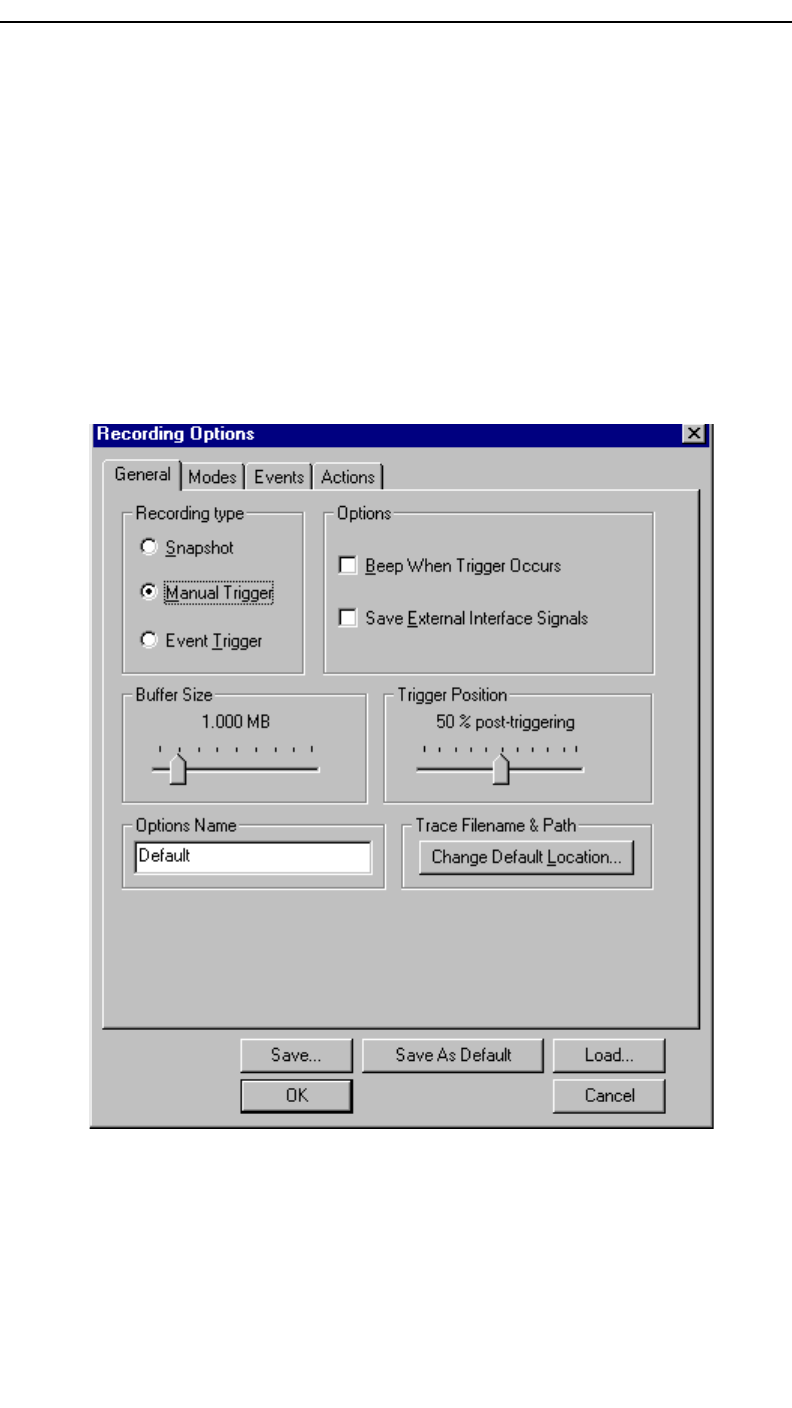
8
Merlin Protocol Analyzer User’s ManualCATC Version 1.6
2.3 Your First Bluetooth™ Recording
After installing and launching the software, you can test Merlin by creating
a recording of a General Inquiry. In this test, Merlin will issue a General
Inquiry that asks local devices to identify themselves. Merlin then records
the responses.
Step 1 Select Recording Options under Setup on the Menu Bar.
Step 2 Select the General tab.
The following dialog box will open showing factory default settings such
as “manual trigger” and 1 Mbytes buffer size. For the General Inquiry
recording you are about to create, these settings can be left unchanged.
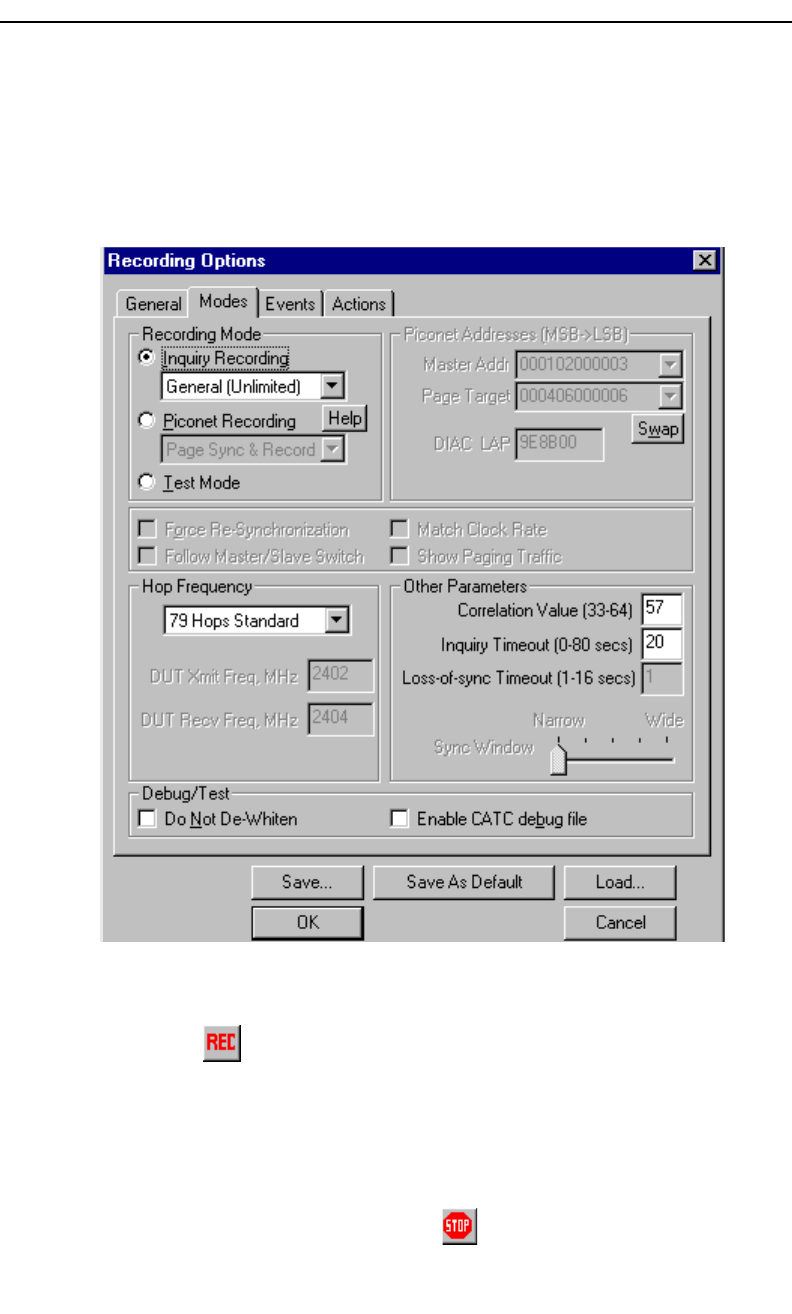
9
Merlin Protocol Analyzer User’s ManualCATC Version 1.6
Step 3 Select the Modes tab.
The following dialog box will open showing factory default settings.
Merlin defaults to “General Inquiry.” For this recording, leave most of
these settings unchanged. If you are recording a Hop Frequency that is
not 79 Hops Standard, you will need to select the appropriate standard
from the Hop Frequency menu below.
Step 4 Click OK to activate the recording options you selected.
At this point, Merlin will be ready to record.
Step 5 Click on the Tool Bar.
Merlin starts to record the Bluetooth™ traffic immediately. The
Bluetooth™ Inquiry process will proceed for 20 seconds. After 20
seconds has elapsed, the analyzer uploads the data and displays the
packets.
Step 6 If you wish to terminate the recording before the snapshot
automatically completes, click on the Tool Bar.
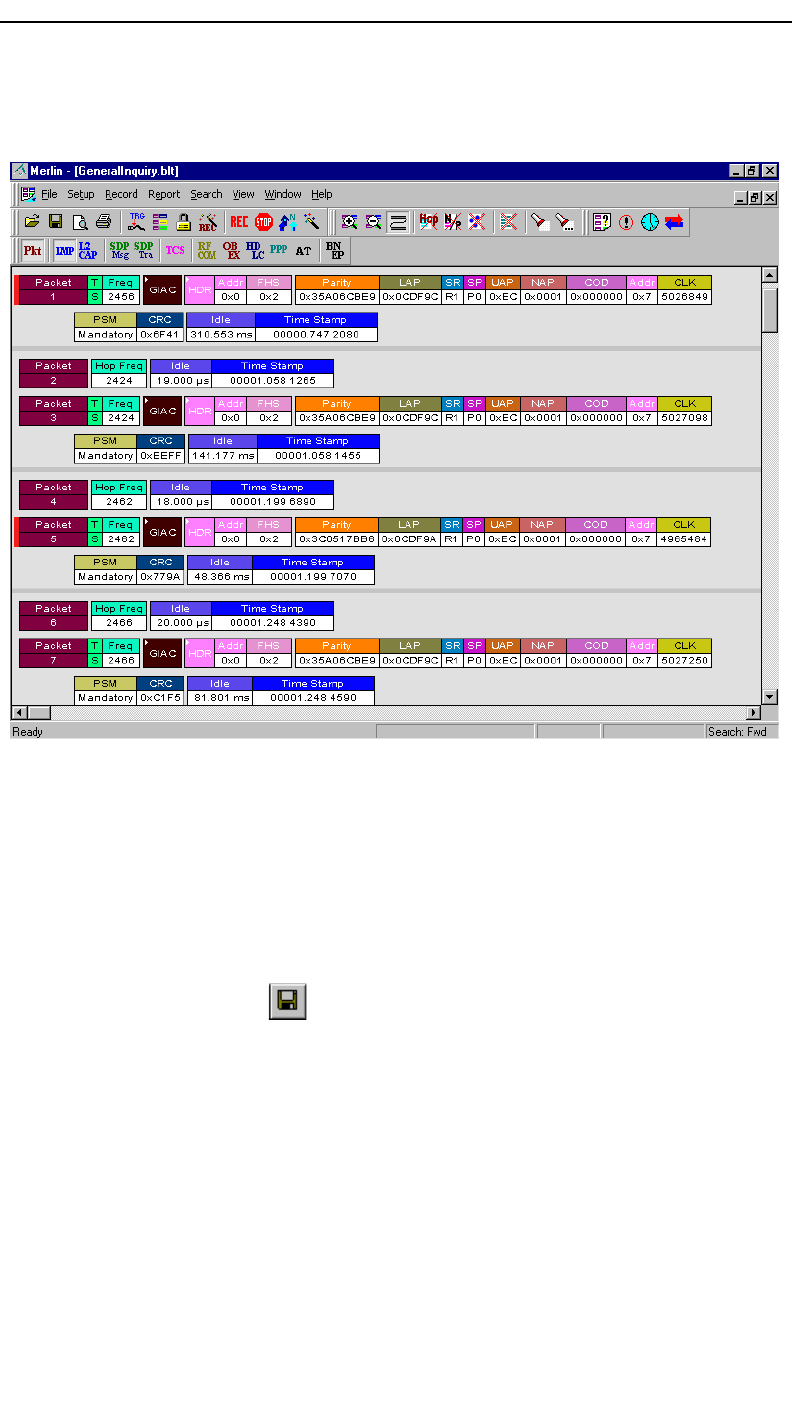
10
Merlin Protocol Analyzer User’s ManualCATC Version 1.6
After a few moments, the recording will terminate and the results will
display. The screen should look like the sample recording below which
shows the FHS packets generated during the Inquiry process.
When the recording session is finished, the bus traffic is saved to the hard
drive as a file named data.blt or whatever name you assign as the default
filename. While the file is being saved, you should see a brown progress
bar at the bottom of the screen. When the bar turns white, it indicates that
the data has been saved to disk.
Step 7 To save a current recording for future reference, Select Save
As under File on the Menu Bar.
OR
Click on the Tool Bar.
You see the standard Save As screen.
Step 8 Give the recording a unique name and save it to the
appropriate directory.
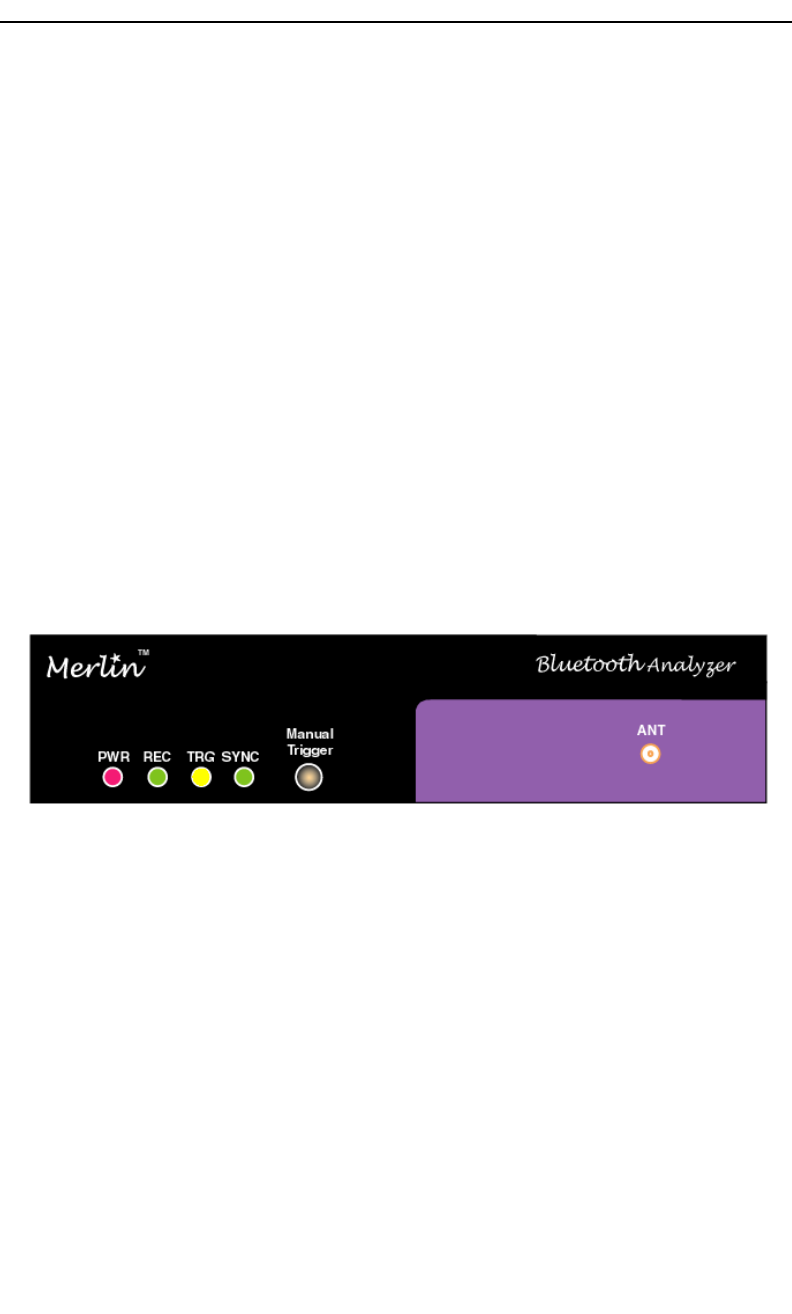
11
Merlin Protocol Analyzer User’s ManualCATC Version 1.6
3. Detailed Installation
3.1 System Components/Packing List
• One stand-alone Merlin Analyzer module
• One Antenna
• One External Interface Breakout Board with a 9-pin ribbon cable
• One 6-foot (2-meter) USB cable
• Merlin software program installation diskette(s)
• Product documentation
3.2 The Installed Merlin Unit
The Merlin Analyzer has several user-accessible controls and LEDs on its
front and rear panels of the OmniBus.
Figure 1: Front Panel
•Red PWR (power) indicator LED (lights when the unit power is
switched on).
•Green REC (recording) LED (lights when the unit is recording).
• Yellow TRG (triggered) LED (lights when the unit triggers an event).
Note TRG also lights during power-on testing and will be turned off at the end of the
power on cycle. If the LED blinks at the end of this cycle, the hardware is faulty.
•Green SYNC (synchronized) LED (lights when the unit is locked onto a
specific piconet, based on the Master Address).
•Manual Trigger push-button (allows a manual Trace capture)
—After beginning a recording session, press the Manual Trigger switch to
force a Trigger condition. The session completes when a specified
post-Trigger amount of bus data is recorded or when you manually stop a
recording session.
•ANT Bluetooth™ Antenna connector

12
Merlin Protocol Analyzer User’s ManualCATC Version 1.6
Figure 2: Rear Panel
•Wide range AC connector module
—Power socket
—Enclosed 5x20 mm 2.0A 250 V fast acting glass fuse
Warning: For continued protection against fire, replace fuse only with the
type and rating specified above.
—Power on/off switch
•External Clock (EXT CLK) input for future enhancement (Note: THIS PORT
IS NOT USED)
•USB type “B” host computer connector
•Data In/Out DB-9 (9-pin) external interface connector
Warning: Do not open the Merlin Analyzer enclosure. There are no
operator servicable parts inside. Refer servicing to CATC.
3.3 Merlin System Setup
The Merlin Analyzer is designed to work with either desktop or laptop
computers equipped with a functional USB interface. To set up the system
hardware,
• Attach the Antenna to the ANT connector. Set the antenna to
point up.
• Connect the Analyzer to an AC power source.
• Connect the External Interface Breakout Board to the Data
In/Out connector (optional).
• Connect to the analyzing PC via USB.
3.4 AC Power Source
Step 1 Connect the Analyzer box to a 100-volt to 240-volt, 50 Hz to
60 Hz, 100 W power outlet using the provided power cord.

13
Merlin Protocol Analyzer User’s ManualCATC Version 1.6
Note The Analyzer is capable of supporting supply voltages between 100-volt and
240-volt, 50 Hz or 60 Hz, thus supporting all known supply voltages around the
world.
Step 2 Use the power switch located on the rear panel to turn the
analyzer unit on and off.
Note At power-on, the analyzer initializes itself in approximately ten seconds and
performs an exhaustive self-diagnostic that lasts about five seconds. The Trigger
LED illuminates during the power-on testing and turns off when testing is
finished. If the diagnostics fail, the trigger LED blinks continuously, indicating a
hardware failure. If this occurs, call CATC Customer Support for assistance.
3.5 External Interface Breakout Board
The External Interface Breakout Board is an accessory that allows
convenient access to several potentially useful standard fast TTL output and
input signals. It also offers a simple way to connect logic analyzers or other
tools to the Merlin Analyzer unit. Four ground pins and one 5-volt pin are
provided.
The Breakout Board connects via a ribbon cable to the Data In/Out
connector located on the rear of the analyzer box. Each pin is isolated by a
100Ω series resistor and a buffer inside the Analyzer box.
Figure 3: Data In/Out Connector
Table 1 lists the pin-out and signal descriptions for the Data In/Out
connector.
Table 1: Data In/Out Connector – Pin-Out
Pin Signal Name Signal Description
1 +5V +5 Volts, 250mA DC source
2 TRG IN Trigger Input
3 GP IN General Purpose Input
4 TRG OUT Trigger Output
5 GP OUT General Purpose Output
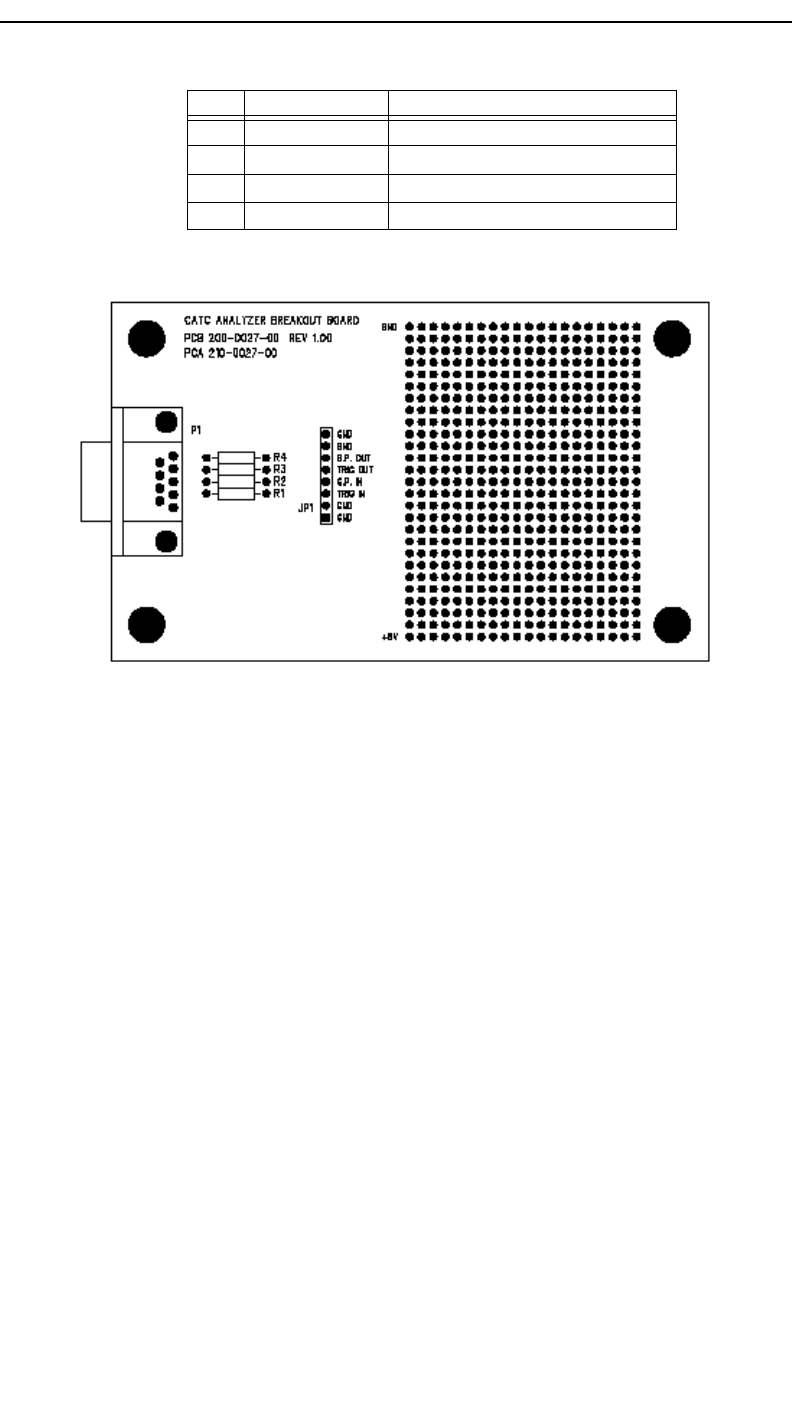
14
Merlin Protocol Analyzer User’s ManualCATC Version 1.6
Table 2: External Interface Breakout Board
Breakout Board External Output Signalling Pins
The "TRG OUT" and "G.P. OUT" pins found on the Analyzer’s Breakout
Board have similar functions. Both pins serve to transmit output signals
when a trigger event occurs. The main differences between the two pins is
in the number of signals that the Analyzer will send through them (TRG
OUT will transmit just one signal whereas G.P. OUT may transmit several
sequential signals), and in their initial state (TRG OUT is always enabled by
the Analyzer whereas G.P. OUT must be enabled in the recording options
before it can be utilized).
TRG OUT
When an event trigger occurs, TRG OUT transitions from ground to a
continuous 5 V signal on the first instance of a trigger event. TRG OUT is
a one-time event: it will not re-signal or change signals with subsequent
triggering events. When this first trigger event occurs, the Trigger LED will
illuminate (so this pin can be thought of as a reflection of the state of this
LED).
6 GND Ground
7 GND Ground
8 GND Ground
9 GND Ground
Pin Signal Name Signal Description

15
Merlin Protocol Analyzer User’s ManualCATC Version 1.6
G. P. O U T
G.P. OUT needs to be enabled before it will output signalling. See “Blue
Dot Menus for the Event Buttons” on page 84 for details on how to enable
output signalling.
If enabled, G.P. OUT will provide signalling each time a trigger event is
detected by the Analyzer. G.P. OUT’s signalling can be set to three
different formats - "Pulse High" provides a 16.66 ns (ground to +5V) signal,
"Pulse Low" a 16.66 ns (+5 V to ground) signal or "Toggle", a signal with
an initial High (+5V) state that alternates with each trigger event between
continuous High (+5 V) and continuous Low (Ground). "Pulse High" is the
default condition. To change the format, see “Enabling High Pulse, Low
Pulse or Pulse Toggle Signal Outputs” on page 84 for details.
Prototype Rework Area
The Breakout Board contains a prototype rework area for making custom
circuits for rapid development. The area consists of plated-through holes, 20
columns wide by 27 rows long. The top row of holes is connected to GND
and the bottom row is connected to +5V. The remaining holes are not
connected. Use the rework area to insert custom components and wire-wrap
their respective signal, power, and ground pins.
3.6 PC Connection
Use the USB cable provided to connect the host computer to the Merlin
Analyzer.
3.7 Antenna Information
According to the Bluetooth™ specifications, Bluetooth™ Antennas should
be placed at least 10 cm apart. It is recommended that Merlin be placed at
least 1 meter away from the nearest device in the piconet under observation.
3.8 Analyzer PC Requirements
• USB connection to the computer (unless using the PC only as a viewer)
• Microsoft Windows 98, Windows 98SE, Windows ME, Windows 2000,
or Windows NT 4.0 for recording and viewing traffic
Note If installing Merlin software on a Windows NT 4.0 system, you will need a special
diskette that is available from CATC.

16
Merlin Protocol Analyzer User’s ManualCATC Version 1.6
• Minimum of 16MB physical RAM; 32 MB recommended for viewing
transactions
• At least 10 MB hard disk space, plus additional memory for recordings
(as much as 200MB when recording a full buffer size)
• Monitor resolution at least 800x600 with thousands of colors
3.9 Merlin Program Installation
The CATC Merlin software is provided on three 3½ inch diskettes and
requires a Windows 98, Windows 98SE, Windows 2000 or Windows ME
operating system. If you are loading Merlin onto Windows NT 4.0 you will
get separate disk and instructions.
You would first need to install Merlin as a USB device and then install the
Merlin Windows application program.
Loading the Merlin USB Drivers
Step 1 Insert the Merlin program floppy for your operating system
labeled Disk 1 of 3 into the a: drive.
Step 2 Power-on the Merlin Analyzer.
Step 3 Connect the USB cable to the rear of the analyzer and to the
personal computer.
The host operating system detects the analyzer and begins to install the
USB driver.
Step 4 Follow the installation instructions provided on your screen
to complete the installation of the driver.
Note When Windows prompts you for a file, browse to the CATC floppy in the a: drive.
Installing the Merlin Application Program
Run Setup.exe from the Merlin floppy disk 1 of 3.
The CATC Merlin Install Wizard automatically installs the necessary files
to the computer’s hard drive. Merlin software is installed in the C:\Program
Files\CATC\Merlin directory unless you specify otherwise. Follow the
installation instructions on your screen.

17
Merlin Protocol Analyzer User’s ManualCATC Version 1.6
3.10 Merlin Program Startup
You can start the Merlin program from the Desktop or from the installed
directory. The program always begins with its main screen active:
The software may be used with or without the analyzer box. When used
without an analyzer box attached to the computer, the program functions in
a Trace Viewer mode to view, analyze, and print captured protocol traffic.
When the program is used with the Merlin Protocol Analyzer attached to the
computer, you can set trigger conditions, record, monitor and analyze the
activity of your Bluetooth™ device or piconet.

18
Merlin Protocol Analyzer User’s ManualCATC Version 1.6
3.11 Making a Recording
After installation, the software is configured to make a manual recording
("Manual Trigger") of General Inquiry traffic.
To make your first recording of this traffic,
Step 1 Click on the Tool Bar.
After 20 seconds, Inquiry timeout occurs and the analyzer will upload the
data and display the packets.
To terminate the recording before Inquiry timeout occurs,
Step 2 Click on the Tool Bar at any time before recording
automatically terminates.
When the recording session is finished, the traffic is saved to the hard
drive as a file named data.blt or whatever name you assign as the default
filename.
To save a current recording for future reference,
Step 3 Select Save As under File on the Menu Bar.
OR
Click on the Tool Bar.
You see the standard Save As screen.
Step 4 Give the recording a unique name and save it to the
appropriate directory.
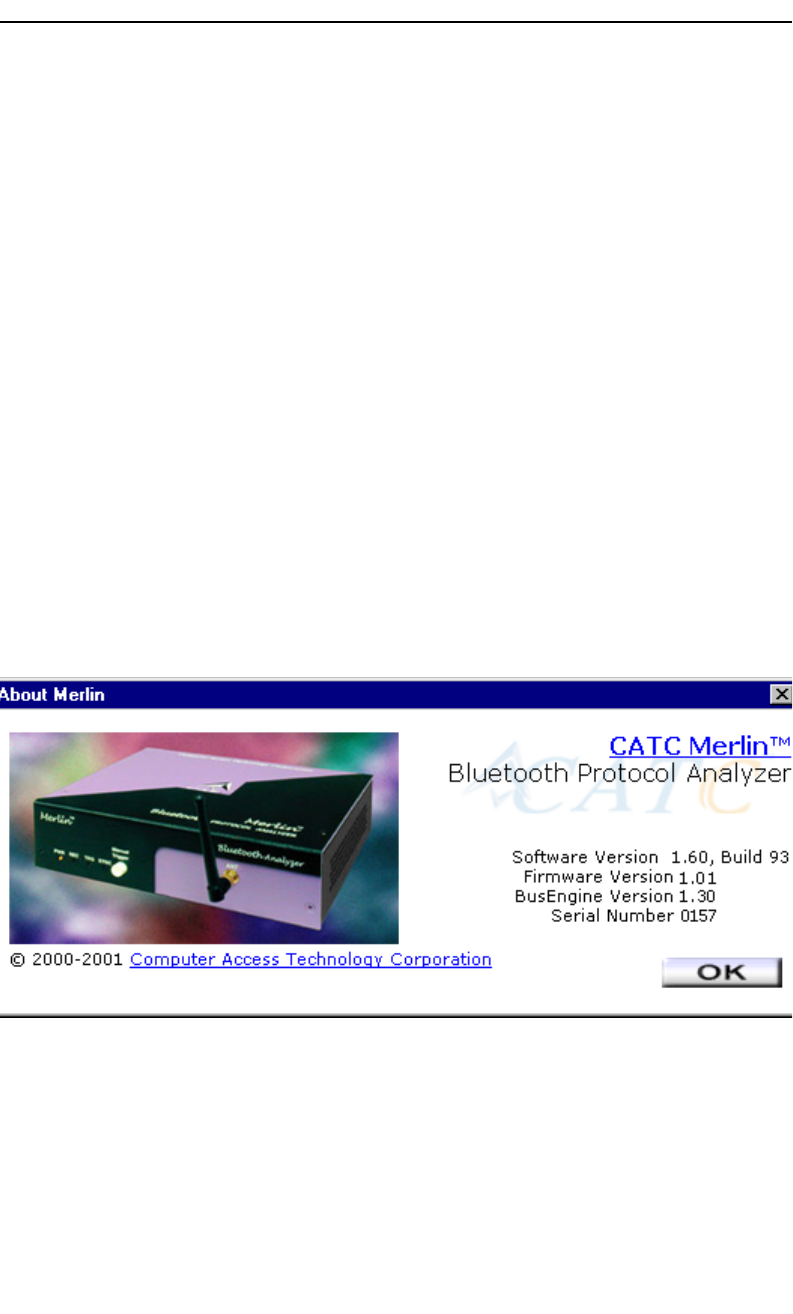
19
Merlin Protocol Analyzer User’s ManualCATC Version 1.6
4. Upgrades
From time to time as modifications are made to Merlin, it is necessary to
update the Firmware and/or BusEngine for optimal performance. Upgrades
can be performed two ways: either automatically or manually. This chapter
describes both procedures.
4.1 Software, Firmware, and BusEngine Revisions
The Readme.txt file on the first installation disk and in the installed
directory gives last-minute updates about the current release. Included with
each release are the most recent downloadable images of the Firmware and
the BusEngine. The Readme.txt file lists the latest versions and informs
you if new Firmware or a new BusEngine needs to be updated in your
hardware.
Once the Analyzer has completed the self diagnostics and is connected to
the PC, you can check the latest revision of the software and BusEngine:
•Selecting About Merlin… in the Help Menu.
You see this screen:
About Merlin details revisions of the following software and hardware:
•Merlin Software Version
•Merlin Firmware Version
•BusEngine Version
•Unit Serial Number
Note When contacting CATC for technical support, please have available all the
revisions reported in the About Merlin window.

20
Merlin Bluetooth Analyzer User’s ManualCATC Version 1.6
4.2 Software Upgrades
When a new software release is available, it is posted on the Support page
of the CATC website at www.catc.com/support.html.
To update the software,
Step 1 In the About Merlin screen, verify which version of Merlin
Software you are currently running.
Step 2 Find the latest released software version on the CATC
website under Support.
If you are running the latest version of the software, no further action is
needed.
If you are not running the latest version, continue to Step 3.
Step 3 Click on the first link to download the zipped Disk 1 files for
your operating system.
Step 4 Click on the second link to download the zipped Disk 2 files.
Step 5 Unzip the files into your choice of directory.
Step 6 Click Start, then Run, and browse to where you unzipped
the files.
Step 7 Select the program named Setup and click Open.
Step 8 Click OK to run the Setup and begin the installation.
Step 9 Follow the on-screen instructions to complete the
installation.
Step 10 Read the Readme file for important information on changes
in the release.
4.3 BusEngine and Firmware Upgrades
BusEngine and Firmware upgrades often need to be performed when you
update the Merlin software. These upgrades can be performed
automatically or manually. Both processes are described.
Automatic Upgrades
When Merlin’s software is upgraded, the software may become
incompatible with the BusEngine and Firmware. If a recording is
attempted, Merlin will display an error message and then automatically
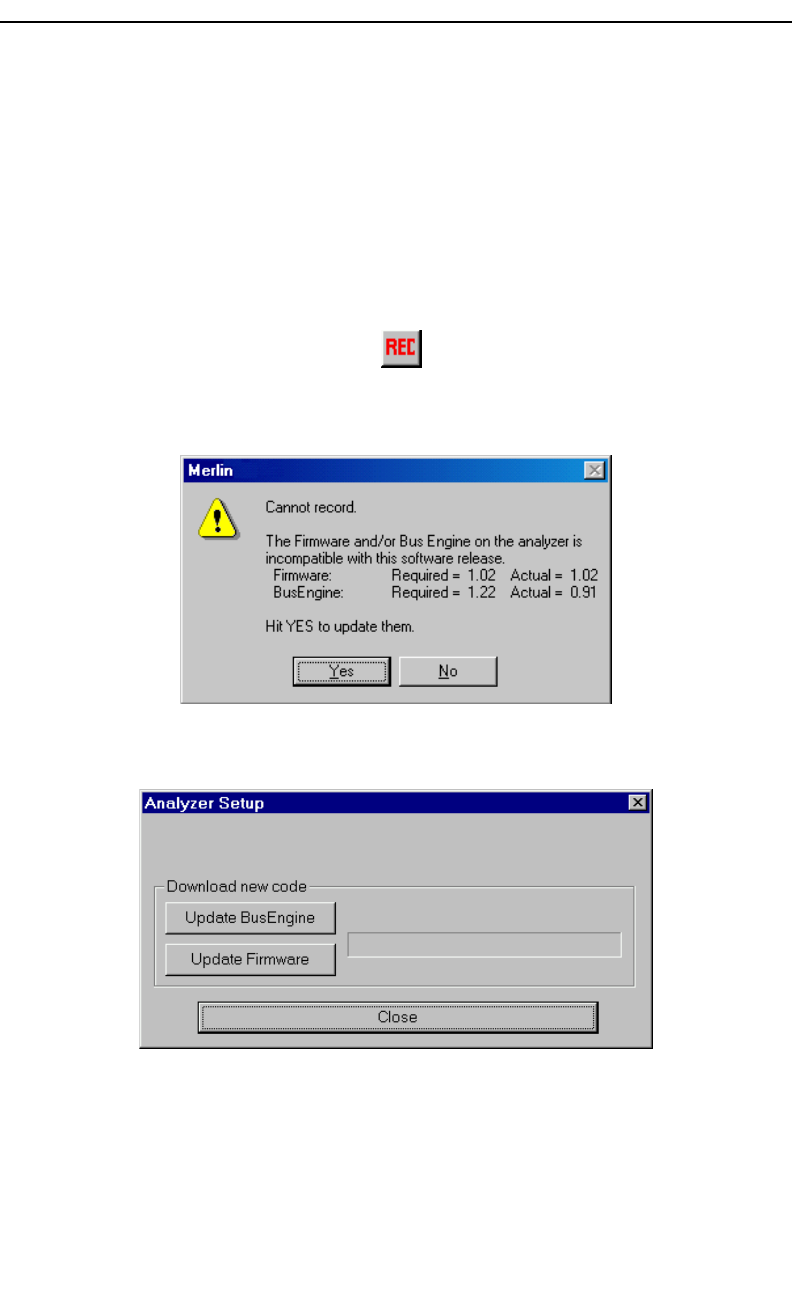
21
Merlin Protocol Analyzer User’s ManualCATC Version 1.6
begin an upgrade process for the BusEngine and Firmware. If you prefer,
you can abort this upgrade and undertake the steps manually as described
later in this chapter.
To perform an automatic BusEngine and Firmware upgrade,
Step 1 If needed, upgrade the Merlin software using the steps
outlined in "Software Upgrades" described above.
Step 1 Turn on the Analyzer.
Step 2 On the toolbar, click the button.
Since the BusEngine and/or the Firmware are incompatible with the
current Merlin software version, an error message will appear displaying
your current versions and indicating what versions you need to install.
Step 3 Click Yes.
The above window closes and the Analyzer Setup window opens.
Step 4 Click Update BusEngine or Update Firmware on the
Analyzer Setup screen.
You can select only one item at this point. If both the BusEngine and the
Firmware need to be updated, the upgrade will complete for the first item
and then return to the above screen so the second upgrade can be
performed.
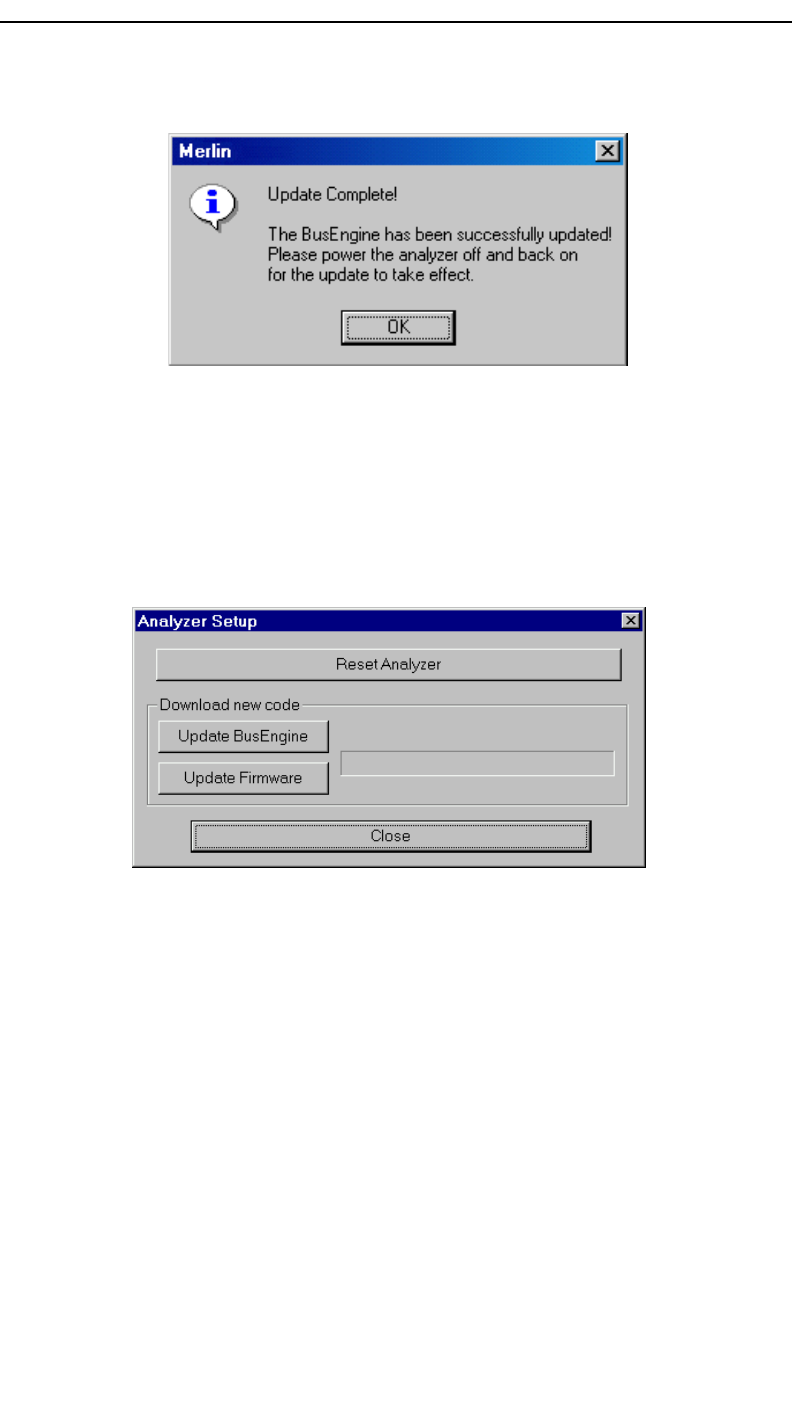
22
Merlin Bluetooth Analyzer User’s ManualCATC Version 1.6
When the second upgrade has finished, you will see the following
message telling you that the upgrade is complete.
Step 5 Power cycle Merlin to complete the upgrade.
Manual Upgrades to BusEngine and Firmware
You can manually upgrade Merlin’s Firmware and/or BusEngine by
performing the following steps:
Step 1 Select Analyzer under Setup on the Menu Bar.
You see the Analyzer Setup screen:
Step 2 Click Reset Analyzer
The Analyzer resets, performs self-diagnostics, and returns to service.
Note The self-diagnostics should complete about five seconds after the trigger LED
lights. If the diagnostics fail, the trigger LED blinks on and off continually,
indicating faulty hardware. If this occurs, contact CATC for customer support.
Upgrading the BusEngine
The BusEngine core is the heart of the Merlin Analyzer. Using
state-of-the-art PLD technology, it incorporates both the high speed
recording engine and the configurable building blocks that implement
data/state/error detections, triggering, capture filtering, external signal
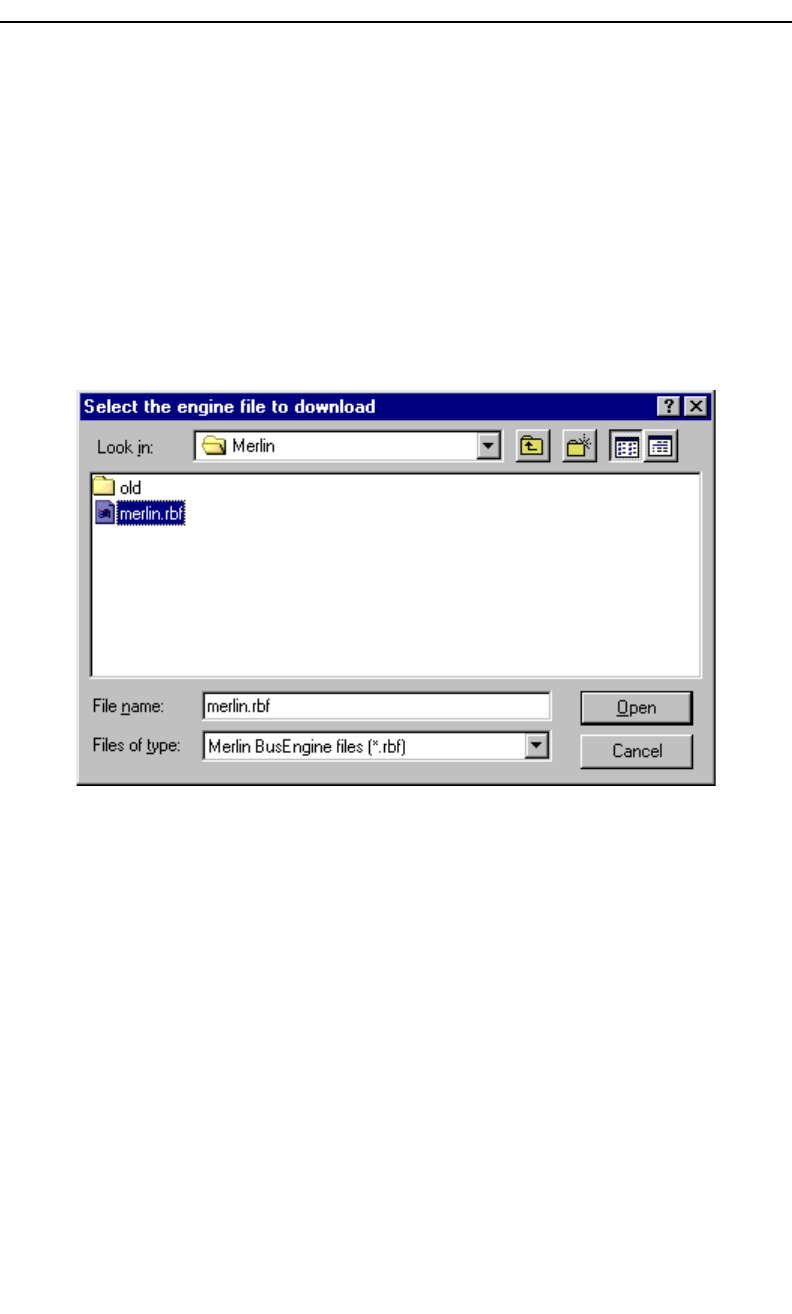
23
Merlin Protocol Analyzer User’s ManualCATC Version 1.6
monitoring, and event counting and sequencing. Both the BusEngine
program and the Firmware that manages the internal microcontroller are
fully field upgradeable.
Within a new software release, it may be necessary to update the Analyzer’s
BusEngine hardware for proper operation. The Readme file lets you know
if this is necessary.
To update the BusEngine,
Step 1 Click Update BusEngine on the Analyzer Setup screen.
You see the Select engine file window:
The program has already automatically searched for the correct file and
displays it in the File name field.
Note The most current Primary BusEngine file (Merlin.rbf) was copied to your
\CATC\Merlin directory when you installed the program.
Step 2 Click Open.
It is not necessary to restart the Analyzer. Once upgraded, the Analyzer
takes approximately 15 seconds to reinitialize, with Time Remaining
displayed on the screen. During this time the Trigger LED is on, indicating
that power-on diagnostics are being run. If there is a hardware failure, the
Trigger LED continues to blink after initialization is complete. If this
occurs, contact CATC for customer support.
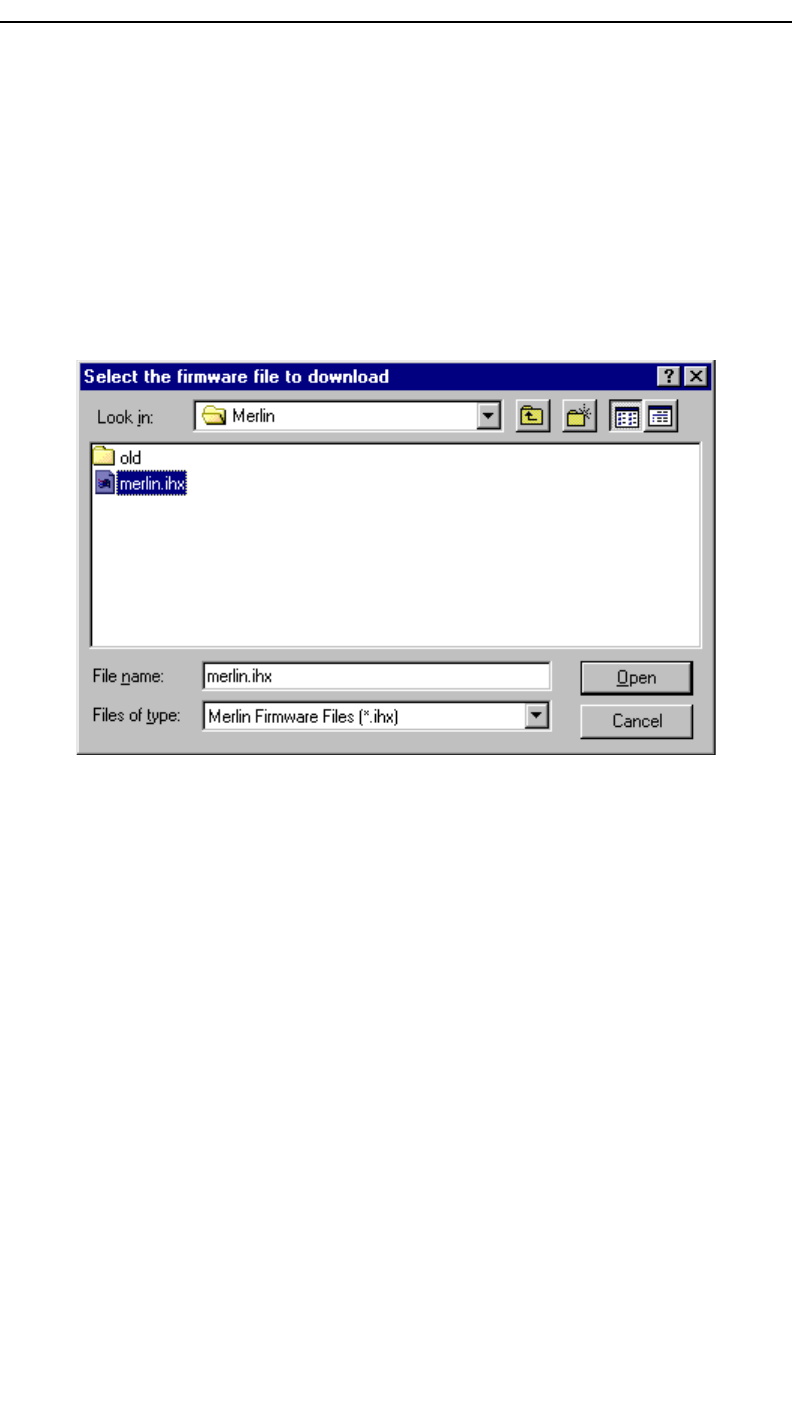
24
Merlin Bluetooth Analyzer User’s ManualCATC Version 1.6
Upgrading the Firmware
Within a new software release, it may also be necessary to upgrade the
Analyzer’s firmware for proper operation. The Readme file informs you if
this is necessary.
To upgrade the firmware,
Step 1 Click Upgrade Firmware on the Analyzer Setup screen.
You see the Select firmware file window:
The program has already automatically searched for the correct file and
displays it in the File name field.
Step 2 Click Open.
The Analyzer upgrades the Firmware.
Step 3 Unplug the USB cable from the back of the Analyzer box
and then reinsert it so the new Firmware upgrade can take
effect.

25
Merlin Protocol Analyzer User’s ManualCATC Version 1.6
5. Software Overview
5.1 The Main Display Windows
While some of the analyzer’s Main Display window options are familiar,
many contain options specific to the analyzer program.
Table 3: Main Display Pull-Down Windows
Menu Function
File
Open…Opens a file
Close Closes the current file
Save As…Saves all or a specified range of packets from the current file with a
specified name
Print…Prints part or all of the current traffic data file
Print Preview Produces an on-screen preview before printing
Print Setup…Sets up your current or new printer
Edit Comment…Creates or edits the Trace file comment field
Export » Packets to
Text (Packet View
Format)
Saves all or part of a trace to a text file or to a Comma Separated
Values (CSV) file suitable for viewing in a spreadsheet application
Export » Packets to
CSV Text
Saves all or part of a trace to a Comma Separated Values (CSV) file
suitable for viewing in a spreadsheet application
Last File Lists the last files that were opened
Exit Exits the Merlin program
Setup
Display Options…Provides the control of various display options such as color, formats,
and filters.
Recording
Options…
Provides setup options for recording, triggering events and filtering
events.
Encryption
Options ...
Allows a pin code to be assigned to a device to facilitate encryption
decoding.
Recording Wizard ... Starts a sequence of interactive dialog boxes that configures Merlin for
a recording. This utility provides an alternative to the Recording
Options dialog box.
Analyzer…Allows the operator to reset the Analyzer or update the BusEngine and
Firmware.
Record
Start Causes the Analyzer to begin recording Bluetooth™ activity.
Stop Causes the Analyzer to stop recording.
Inquiry » General Analyzer initiates General Inquiry to all devices within range and
records response packets.
Inquiry » Dedicated Analyzer initiates inquiry to a class or group of devices specified by the
DIAC LAP text box under the Modes tab in Recording Options dialog.

26
Merlin Protocol Analyzer User’s ManualCATC Version 1.6
Piconet » Sync &
Record
Used when the Bluetooth™ devices under observation have not
established connection.
Piconet » Passive
Sync & Record
Used when Bluetooth™ devices under observation are already
connected.
Piconet » Page Sync
& Record
This mode causes Merlin to perform a General Inquiry and collect sync
data from the specified slave device. "Page Sync & Record" is the
recommended method of recording. Use this mode when the devices
under observation have not established connection.
Test Mode Allows Merlin’s Hop Frequency to be set.
Report
File Information Details such information about the recording as number of packets and
triggering setup.
Error Summary Displays an error summary of the current trace file and allows you to
go to a specific packet, and save the error file to a uniquely named file.
Timing Calculation Starts the calculator dialog for calculating various timing and
bandwidth parameters in the recording file.
Traffic Summary Details the number and type of packets were transferred during the
recording, as well as message-level statistics.
Search
Go to trigger Positions the display to show the first packet that follows the trigger
event.
Go to
Packet/Message/
Protocol ...
Positions the display to the indicated packet, LMP/L2CAP message, or
Protocol Message (RFCOMM, TCS, or SDP protocols).
Go to Marker » Positions the display to a previously marked packet
Go to » Enables quick searching for specific events using a cascade of pop-up
windows.
Error Positions the display to the next hard error.
Soft Bit Error Positions the display to the next soft bit error. A Soft Bit error is an
error that is correctable though the Merlin software.
Loss of Sync Allows searching for loss of sync.
Find Allows complex searches.
Find Next Repeats the previous Find operation. Can also use F3 to find next.
Search Direction Allows you to specify a forward or backward search of a trace file.
View
Toolbars Displays list of available toolbars.
Status Bar Switches display of the Status Bar on or off.
Zoom In Zoom in increases the size of the displayed elements.
Zoom Out Zoom out decreases the size of the displayed elements.
Wrap Allows the display to wrap.
Menu Function

27
Merlin Protocol Analyzer User’s ManualCATC Version 1.6
5.2 View Options
The View feature in the Menu Bar allows you to
•Control the display of the Tool Bar and the Status Bar.
Tool Bar
The Tool Bar provides access to the most popular program functions. Tool tips
describe icon functionality as the mouse arrow is moved over the icon/item.
BT Neighborhood Displays Bluetooth™ Address and clock frequency for devices in
range. The expected Bluetooth™ clock frequency is 3200 Hz +/- 250
ppm.
Decoding
Assignments
Displays current decoding assignments and provides options for
changing them.
L2CAP connections Displays current L2CAP connections and provides options for
changing them.
RFCOMM Channel
Assignments
Displays current RFCOMM Channel Assignments and provides
options for changing them.
Window
New Window Switches display of the Tool Bar on or off.
Cascade Displays all open windows in an overlapping arrangement.
Tile Displays all open windows in a side-by-side arrangement.
Arrange Icons Arranges minimized windows at the bottom of the display.
Windows Displays a list of open windows.
Help
Help Topics Displays online help.
About Merlin Displays version information about Merlin.
Open file Hide Nulls & Polls
Save As Hide Unassociated Traffic
Preview Complex Find
Menu Function
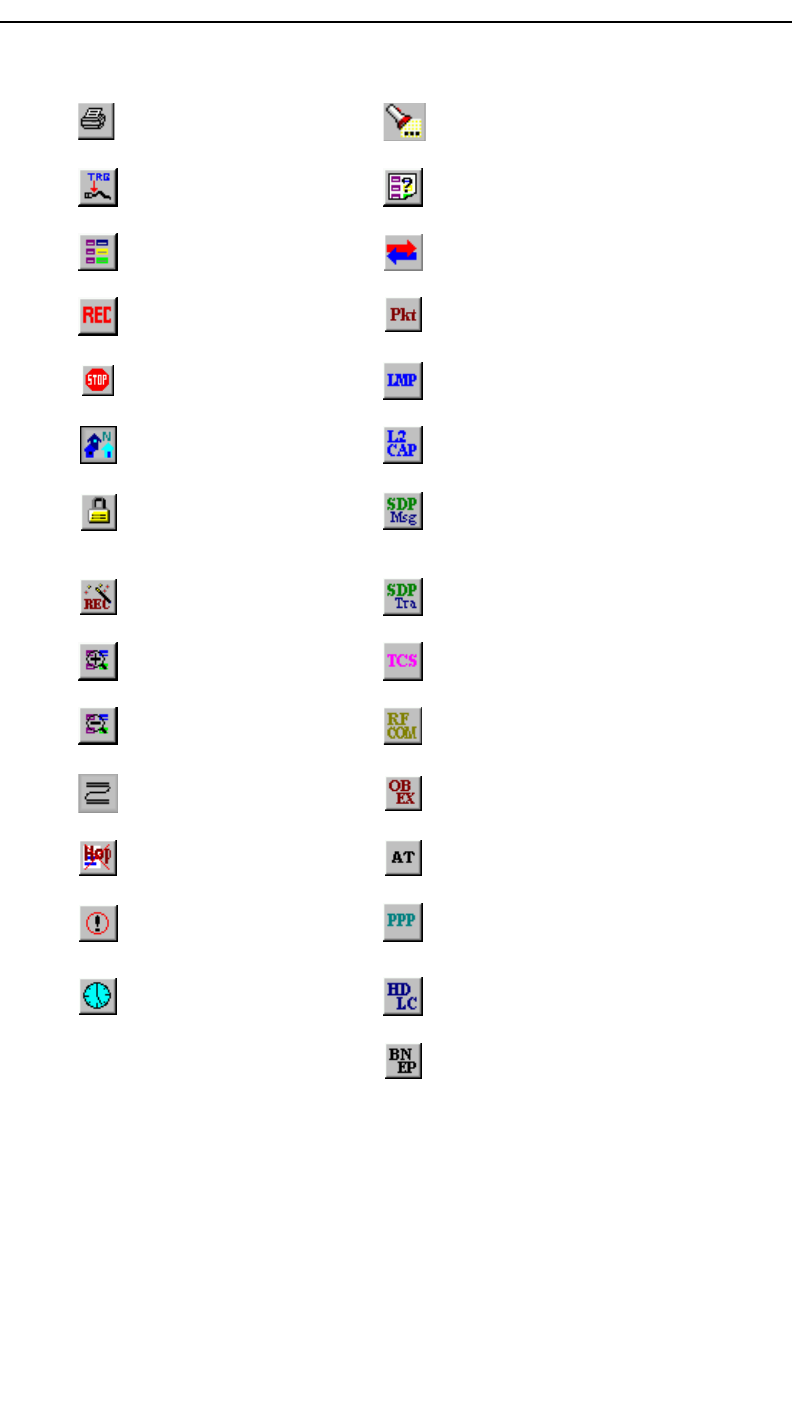
28
Merlin Protocol Analyzer User’s ManualCATC Version 1.6
Print… Find Next
Setup Record Options File Information Report
Setup Display Options Traffic Summary
Start Recording View Packet Level (Baseband)
Stop Recording View/Hide LMP Message Level
Bluetooth Neighborhood View/Hide L2CAP Message Level
Setup Encryption Options View/Hide SDP Message Protocol Level
Recording Wizard View/Hide SDP Transaction Protocol Level
Zoom In View/Hide TCS Protocol Level
Zoom Out View/Hide RFCOMM Protocol Level
Wrap View/Hide OBEX Protocol Level
Hide Frequency Hops View/Hide AT Commands
Error Summary View/Hide PPP
Timing Calculations View/Hide HDLC Protocol
View/Hide BNEP Protocol
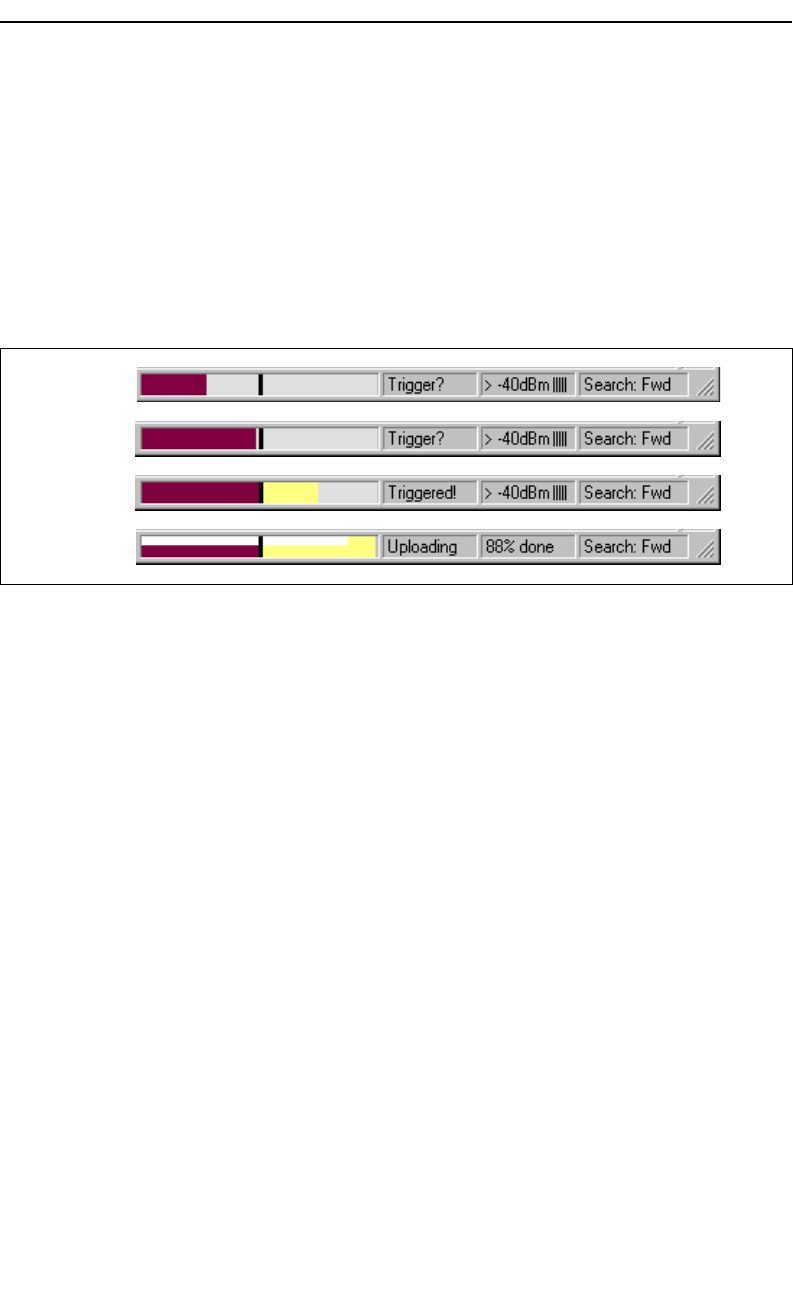
29
Merlin Protocol Analyzer User’s ManualCATC Version 1.6
5.3 Status Bar
The Status Bar is located at the bottom of the main display window.
Depending on the current activity, the bar can be divided into as many as
four segments.
Recording Progress
When you begin recording, the left-most segment of the Status Bar displays
a Recording Progress Indicator:
As recording progresses, the Progress Indicator changes to reflect the
recording progress graphically:
•In the Progress Indicator, a black vertical line illustrates the location of the
Trigger Position you selected in Recording Options.
—Pre-Trigger progress is displayed in the field to the left of the Trigger
Position in the before-Trigger color specified in the Display Options.
—When the Trigger Position is reached, the progress indicator wiggles as it
waits for the trigger.
—After the trigger occurs, the field to the right of the Trigger Position fills
in the post-Trigger color specified in the Display Options.
—When recording is complete, the upper half of the progress indicator fills
in white, indicating the progress of the data upload to the host computer.
You should be aware of two exceptional conditions:
•If a Trigger Event occurs during the before-Trigger recording, the
before-Trigger color changes to the after-Trigger color to indicate that not all
the expected data was recorded pre-Trigger.
•When you click Stop before or after a Trigger Event, the Progress Bar adjusts
accordingly to begin uploading the most recently recorded data.
The Progress Bar fills with color in proportion to the specified size and
actual rate at which the hardware is writing and reading the recording
memory. However, the Progress Indicator is normalized to fill the space
within the Status Bar.

30
Merlin Protocol Analyzer User’s ManualCATC Version 1.6
Recording Status
During recording activity, the current Recording Status is temporarily
displayed in the next segment. When you activate the Record function, this
segment flashes one of the following messages (depending on the selected
Recording Options):
—Trigger?
—Triggered!
—Uploading
After recording stops,
—The flashing message changes to Uploading data–x% done (x%
indicates the percentage completion of the data uploading process).
—The traffic data is copied to disk (overwriting any previous version of this
file) using the default file name data.blt or a new name specified in the
Recording options.
To abort the upload process,
•Press Esc on your keyboard
OR
Again click in the Tool Bar.
You are prompted to choose whether to keep the partially uploaded data or to
throw it away.
When the data is saved, the Recorded Data file appears in the main display
window and the Recording Status window is cleared.
•If the recording resulted from a Trigger Event, the first packet following the
Trigger (or the packet that caused the Trigger) is initially positioned second
from the top of the display.
•If the recording did not result from a Trigger Event, the display begins with the
first packet in the traffic file.
Analyzer Status
The third segment in the status bar displays analyzer status. During
synchronization, the analyzer status will read:
Inquiring – Merlin is conducting a General Inquiry
Syncing – Merlin is syncing to the Master device
No Sync – Merlin has not yet started syncing to the Master device
After the analyzer has synchronized to the Bluetooth™ piconet under
observation, the Status Bar will display activity bars. The activity bars will
increase or decrease with activity. If there are no vertical bars, there is no
recorded activity.

31
Merlin Protocol Analyzer User’s ManualCATC Version 1.6
During uploading, this segment displays the percent of the upload process
completed.
Note If packets are filtered from the recording or data are truncated, the recording
activity is reduced.
In addition to showing activity, the third segment of the Status Bar will also
display the radio signal strength in dBm received by the analyzer. Merlin
can display five possible values:
• below -60 dBm
• - 60 dBm
• - 50 dBm
• - 40 dBm
• above - 40 dBm
The valid range for a signal is between -70 and - 20 dBm.
Search Status
The rightmost segment displays the current search direction: Fwd (forward)
or Bwd (backward).
Zoom In
Zoom In increases the size of the displayed elements, allowing fewer (but
larger) packet fields per screen.
•Click on the Tool Bar.
Zoom Out
Zoom Out decreases the size of the displayed elements, allowing more (but
smaller) packet fields per screen.
•Click on the Tool Bar.
5.4 Tool Tips
Throughout the application, tool tips provide useful information.
To display a tool tip, position the mouse pointer over an item. The tool tip
displays in a short moment if present. Tool tips can also be found over the
Tool Bar and in areas of the packet view screen.

32
Merlin Protocol Analyzer User’s ManualCATC Version 1.6
5.5 Merlin Analyzer Keyboard Shortcuts
Several frequently-used operations are bound to keyboard shortcuts.
Table 4: Keyboard Shortcuts
Key Combination Operation Key Combination Operation
Ctrl+O Open file Ctrl+P Print...
Ctrl+Home Jump to First packet Ctrl+End Jump to Last packet
Ctrl+F Search Forward Ctrl+B Search Backward
F3 Find Next Ctrl+L Search for Loss of Sync
Shift+I Goto ID packet Shift+R Goto Freq Hop packet
Shift+P Goto Poll packet Shift+N Goto Null packet
Shift+M Goto DM1 packet Shift+F Goto FHS packet
Shift+1 Goto HV1 packet Shift+H Goto DH1 packet
Shift+3 Goto HV3 packet Shift+2 Goto HV2 packet
Shift+A Goto AUX1 packet Shift+V Goto DV packet
Shift+5 Goto DH3 packet Shift+4 Goto DM3 packet
Shift+7 Goto DH3 packet Shift+6 Goto DM5 packet
Shift+S Search for Soft Error Shift+E Search Error
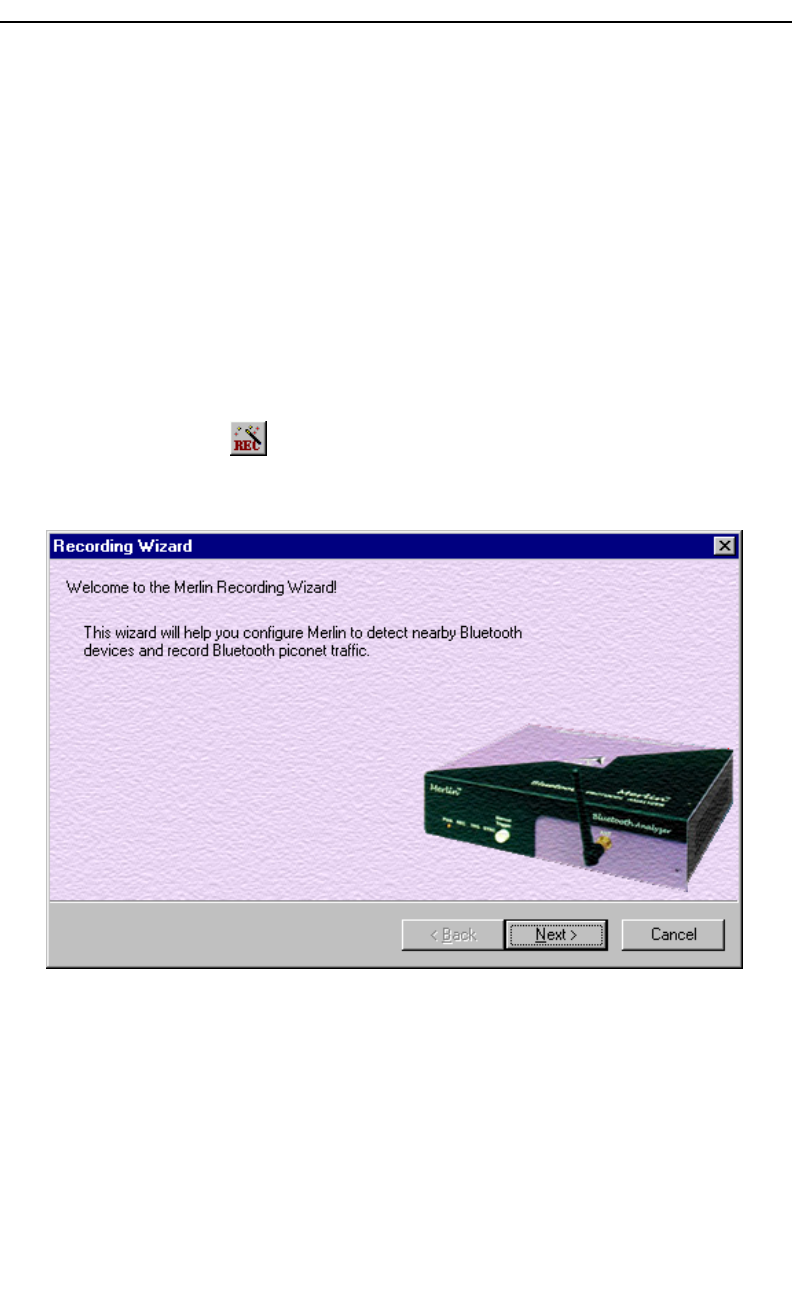
33
Merlin Protocol Analyzer User’s ManualCATC Version 1.6
6. Recording Wizard
Recording Wizard is an interactive utility that presents a series of
user-friendly dialog boxes for setting up a recording session. Recording
Wizard serves as an alternative method of configuring the Recording
Options dialog box - in fact, when you finish using the Wizard you can see
that your settings are . By providing data to the prompts in the Wizard’s
dialog boxes, you configure Merlin for a recording session.
Starting Recording Wizard
To start the Recording Wizard,
• Click on the Tool Bar or select Recording Wizard under
Setup on the Menu Bar.
You see the Recording Options window:
The Recording Options window has three buttons marked Next, Back, and
Cancel that allow you to move forward or backward through the wizard or
to cancel the wizard.
To begin advancing through the wizard,
•Click Next to see the options for the three types of recordings that
the Recording Wizard can make.
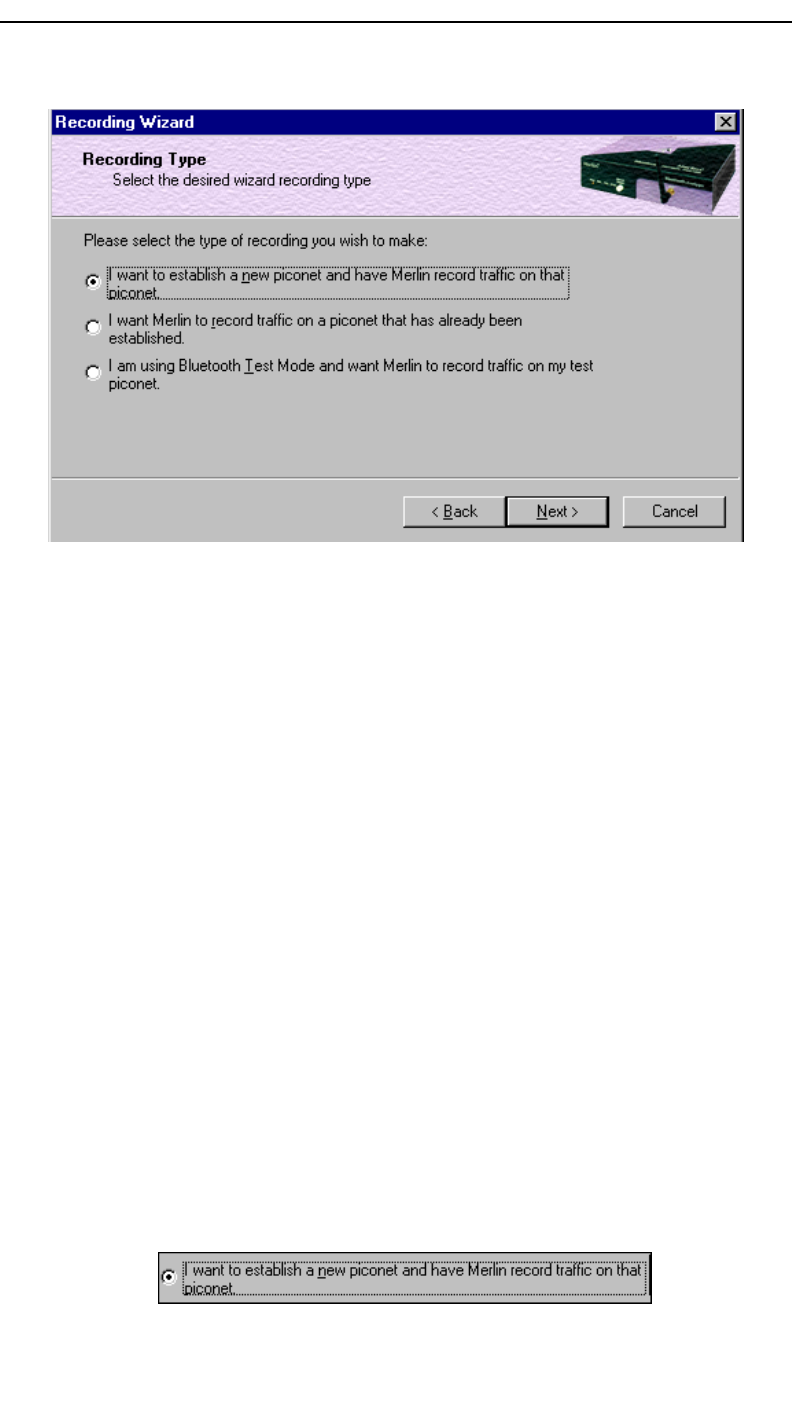
34
Merlin Protocol Analyzer User’s ManualCATC Version 1.6
The Wizard advances to the next screen which presents three options:
•Establish a new piconet and have Merlin record traffic on
that piconet.
This option causes Merlin to perform an Inquiry so it can discover local
devices and then establish a new piconet and record the piconet traffic.
•Record traffic on a piconet that has already been established.
This option lets Merlin record traffic from an already established piconet.
•Record traffic in Test Mode on a test piconet.
This option lets Merlin create either a single frequency range recording
of a range that you specify or create a recording of a limited hop
frequency range consisting of 5 frequency hops.
6.1 Recording a Traffic on a New Piconet
The New Piconet option shown in the previous screen presents users with
the means of recording the traffic from a new piconet. This option will
cause a sequence of screens to prompt you for information such as the
piconet Master address.
The following steps shows you how to configure Merlin to record a new
piconet.
Step 1 From the screen shown in the previous screenshot, select the
first option: I want to establish a new piconet and have
Merlin record traffic on that piconet, then press Next.
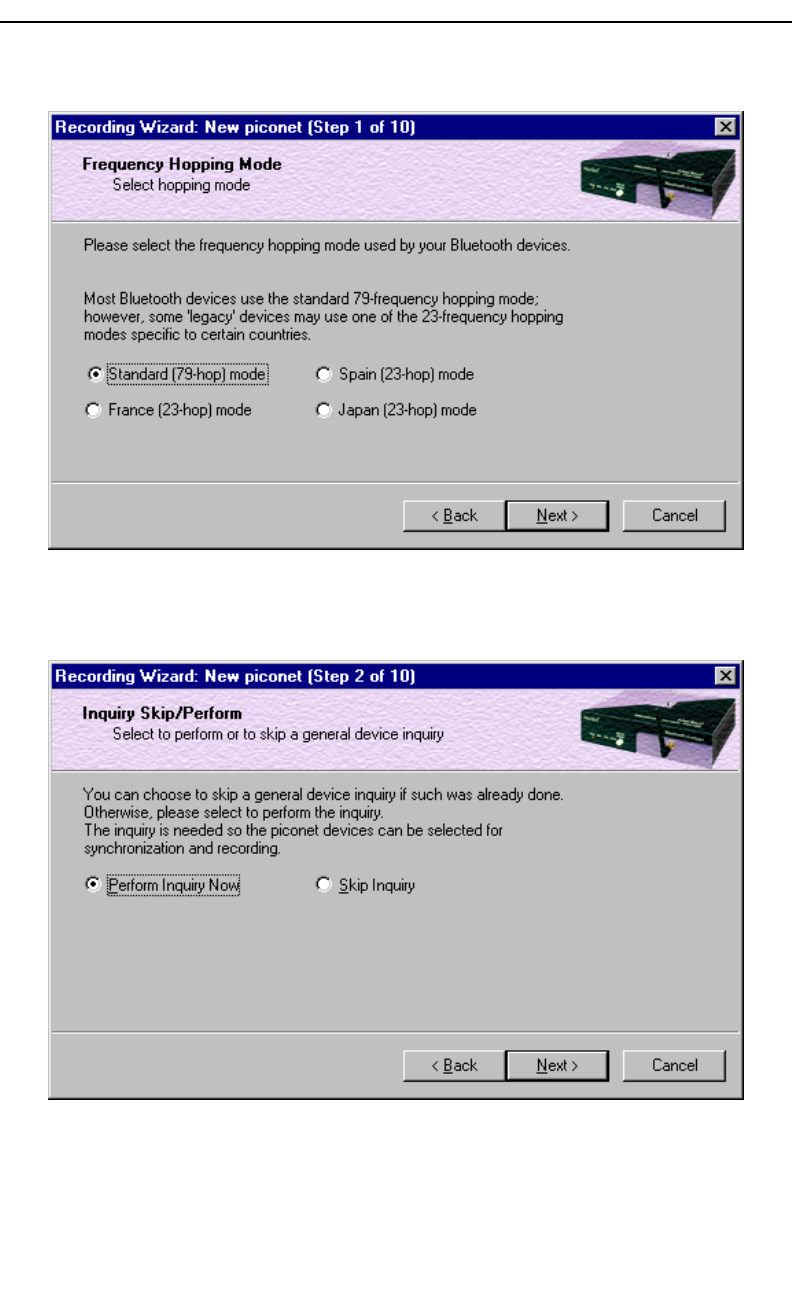
35
Merlin Protocol Analyzer User’s ManualCATC Version 1.6
The following screen displays.
Step 2 Select the Frequency Hopping Mode for your country, then
press Next.
The following screen displays.
Step 3 Select Perform Inquiry Now, then press Next.
Selecting Perform Inquiry Now will cause Merlin to perform a General
Inquiry and collect addresses and other details about local Bluetooth
devices. If you already have address information for your Bluetooth
devices you can choose Skip Inquiry. Choosing Skip Inquiry will
cause the Recording Wizard to advance to Step 8. If you are not sure
what option to select, choose Perform Inquiry Now.
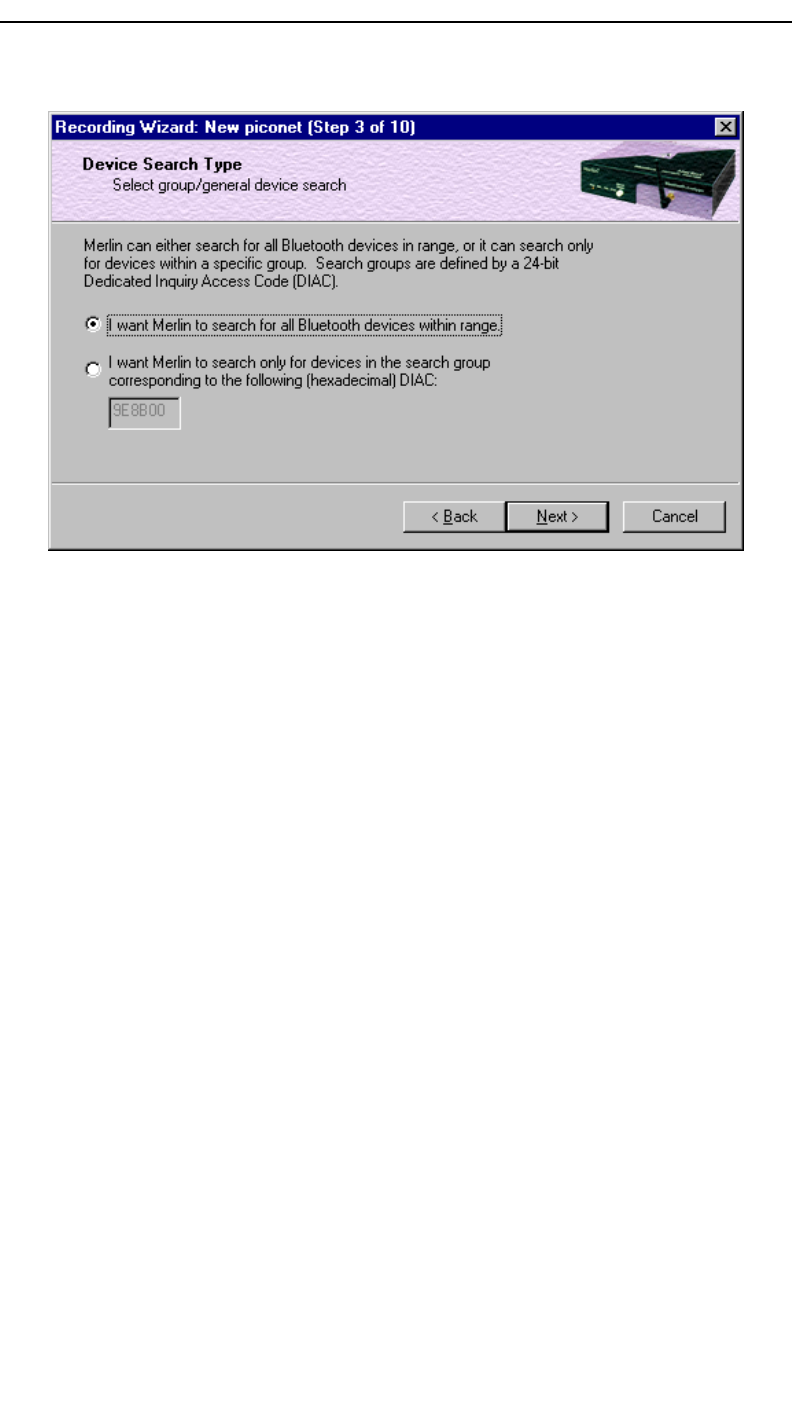
36
Merlin Protocol Analyzer User’s ManualCATC Version 1.6
The following screen will display.
You will see two options:
•I want to search for all Bluetooth devices within range
This option will cause Merlin to search for all Bluetooth devices that are
in range and ready to transmit and receive data (i.e., in Inquiry Scan
Mode)
•I want to search only for devices corresponding to the
following (hexadecimal) DIAC:
This option will cause Merlin to search for the class of devices that you
specify in the DIAC text box. DIAC stands for Device Inquiry Access
Code. Values are entered in hexadecimal format. You can get DIAC
values from the Bluetooth Specification.
Step 4 Select the first option: I want to search for all Bluetooth
devices within range, then press Next.The following screen
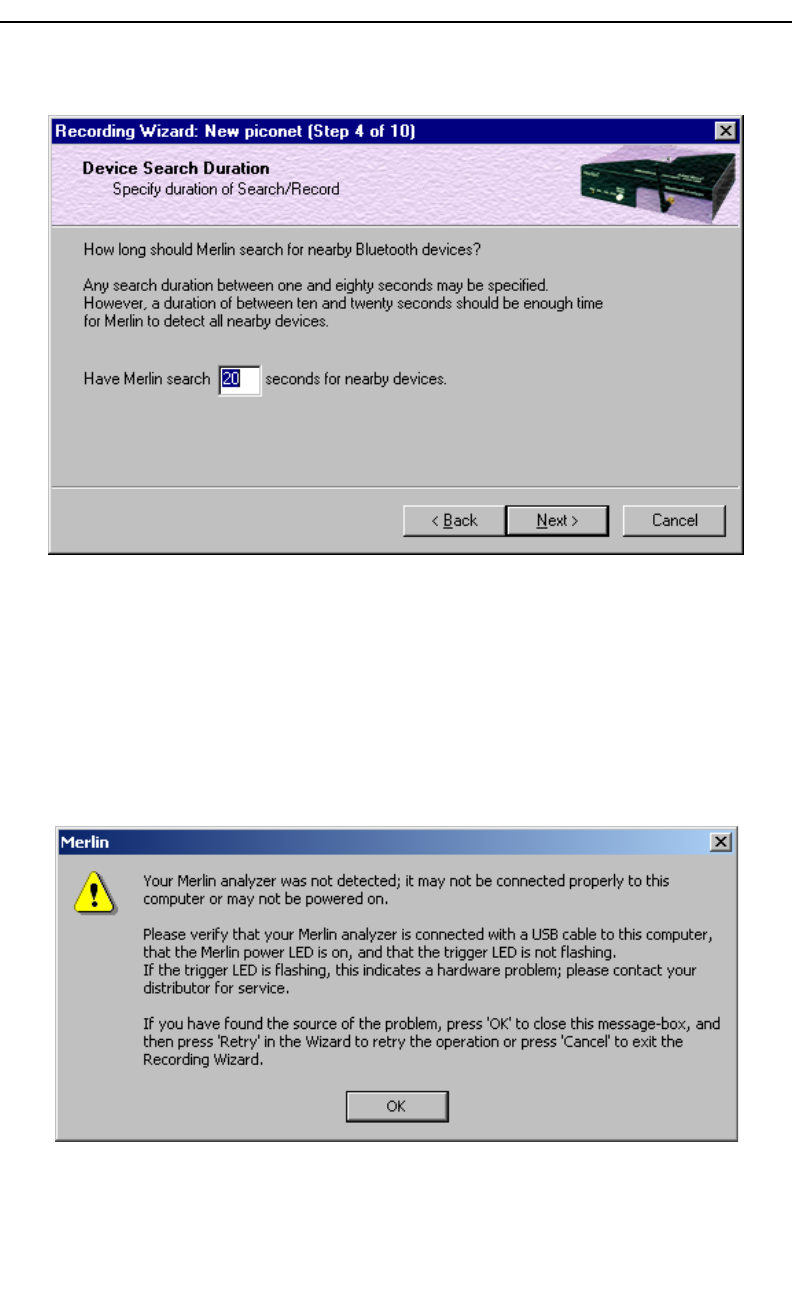
37
Merlin Protocol Analyzer User’s ManualCATC Version 1.6
will display.
You will see two options:
Step 5 In the text box, enter the length of time you want Merlin to
search for nearby devices.
The default value is 20. If you do not sure what time value to enter, use
the default value.
Step 6 Press Next.
Before the Inquiry, Merlin tests the hardware connection. In the case of
failure, the following screen will display.
Clicking OK will close the message box.
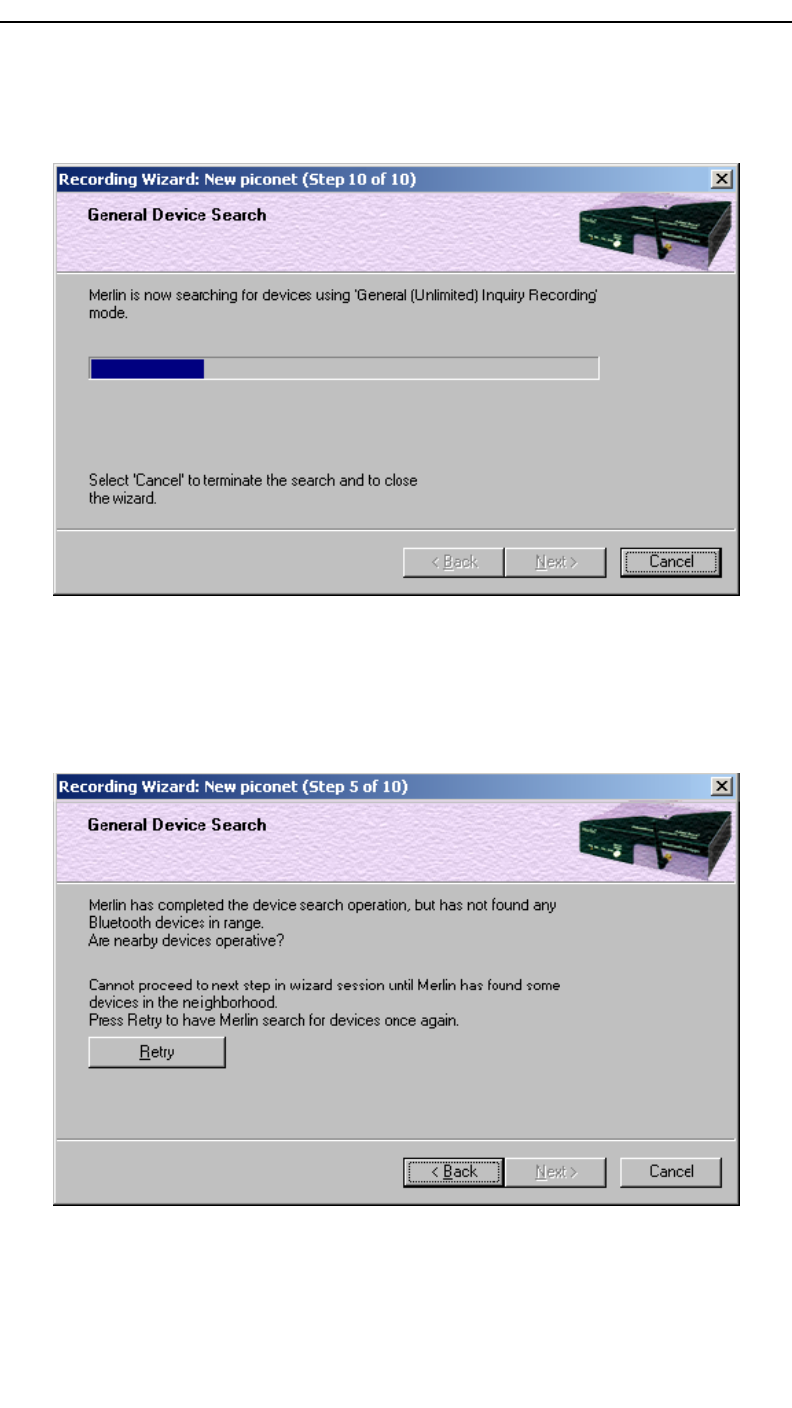
38
Merlin Protocol Analyzer User’s ManualCATC Version 1.6
If Merlin passes the hardware test, it will search for devices. The
Recording Wizard will display a progress bar and a message telling you
that a search is under way:
If no device is found, the Recording Wizard will display the following
screen:
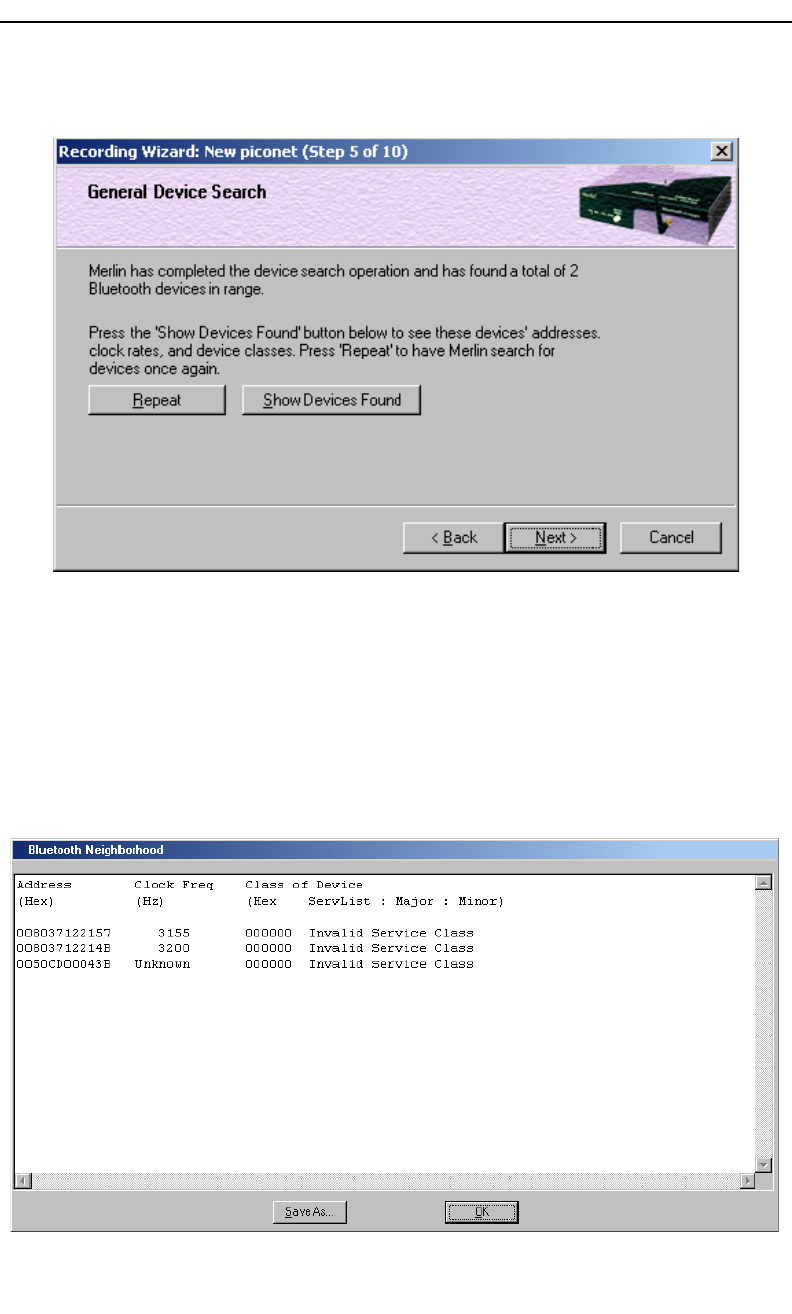
39
Merlin Protocol Analyzer User’s ManualCATC Version 1.6
If devices found, the Recording Wizard will display the following
screen:
Two buttons will display:
•Repeat - This button will cause Merlin to repeat the General
Inquiry
•Show Devices Found - This button will cause a window to open
and display details about the found devices.
Step 7 Press the button marked Show Devices Found.
The following screen will display:
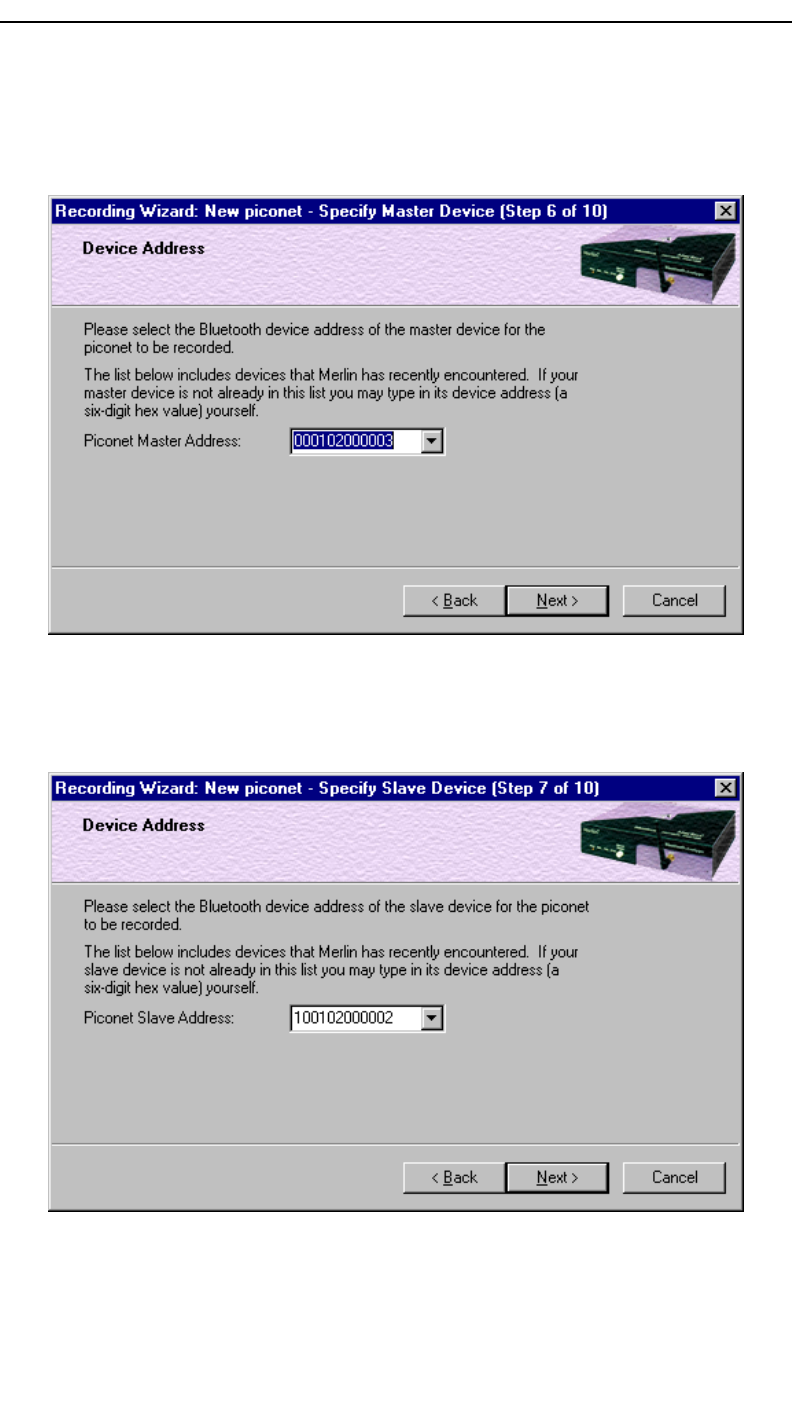
40
Merlin Protocol Analyzer User’s ManualCATC Version 1.6
Step 8 Click OK to close the window.
Step 9 Press Next.
The following window will display:
Step 10 Select from the drop-down menu the hexadecimal address for your
Master device. If you do not see your device’s address, you may
type it into the text box yourself.
The following window will display:
Step 11 Select from the drop-down menu the hexadecimal address for your
slave device into the box labeled Piconet Slave Address. If you do
not see your slave’s address, you can type it into the box.
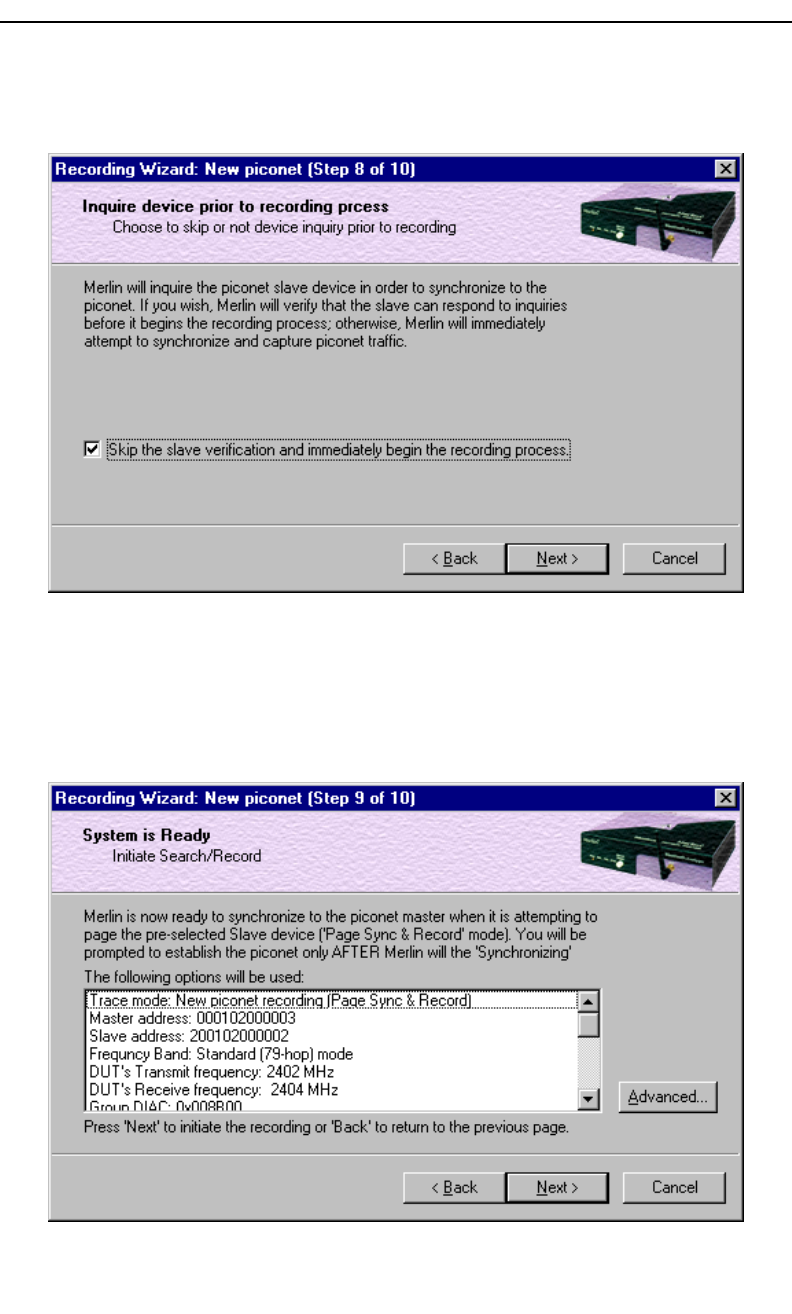
41
Merlin Protocol Analyzer User’s ManualCATC Version 1.6
Step 12 Press Next.
The following screen displays.
You will see a checkbox marked Skip the verification and immediately
begin the recording process. If you uncheck this box, Merlin will
perform a device inquiry on the slave device in Step 10 before it attempts
to synchronize to the piconet.
Step 13 Press Next.
The following screen will display.
This screen displays the settings you selected.
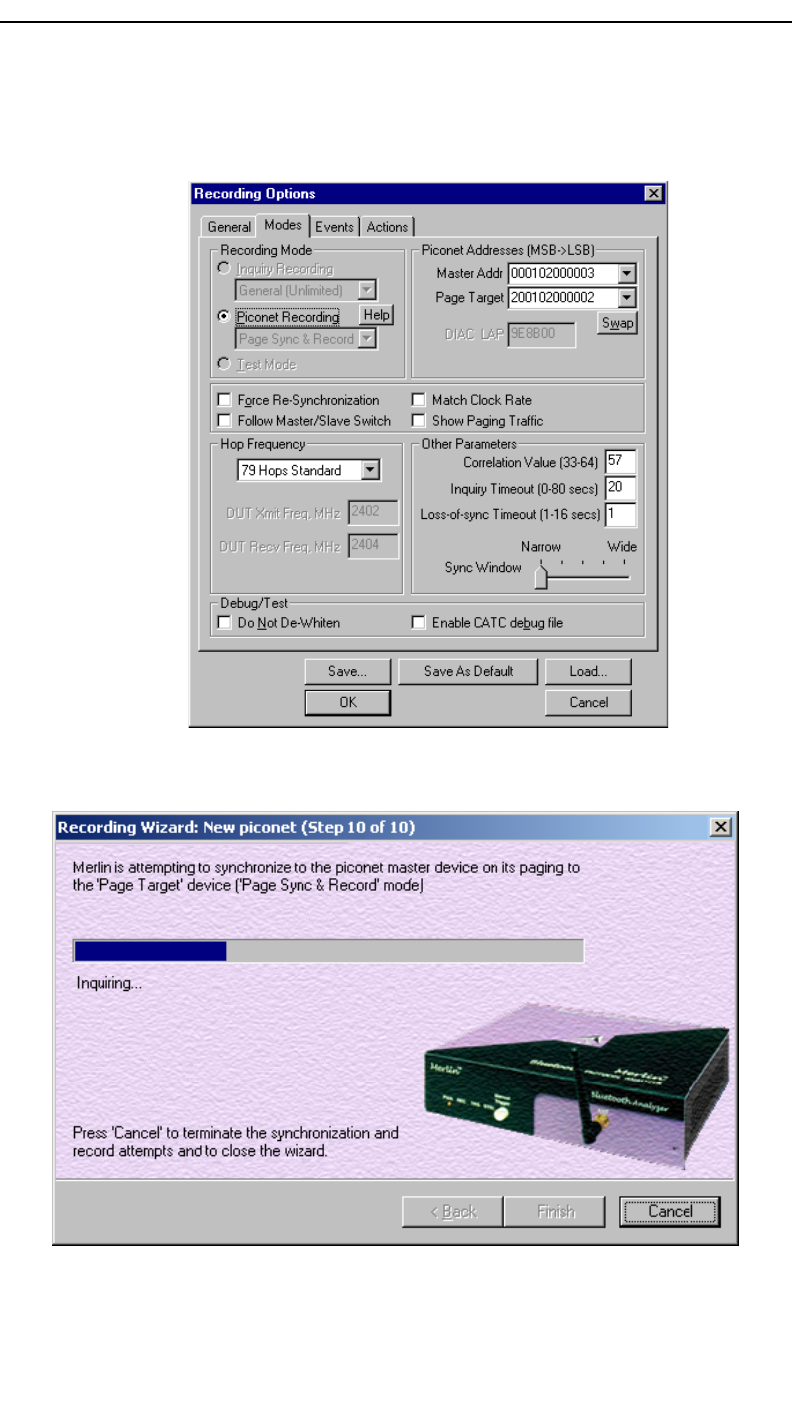
42
Merlin Protocol Analyzer User’s ManualCATC Version 1.6
The Advanced button on the right will open the Recording Options
dialog box shown below. This screen will show the settings you selected
through the Recording Wizard have been applied to the Recording
Options dialog.
Step 14 Press Next to advance the Recording Wizard to the next screen.
The following screen displays:
Merlin pages the Master and if specified in Step 8, the Slave devices.
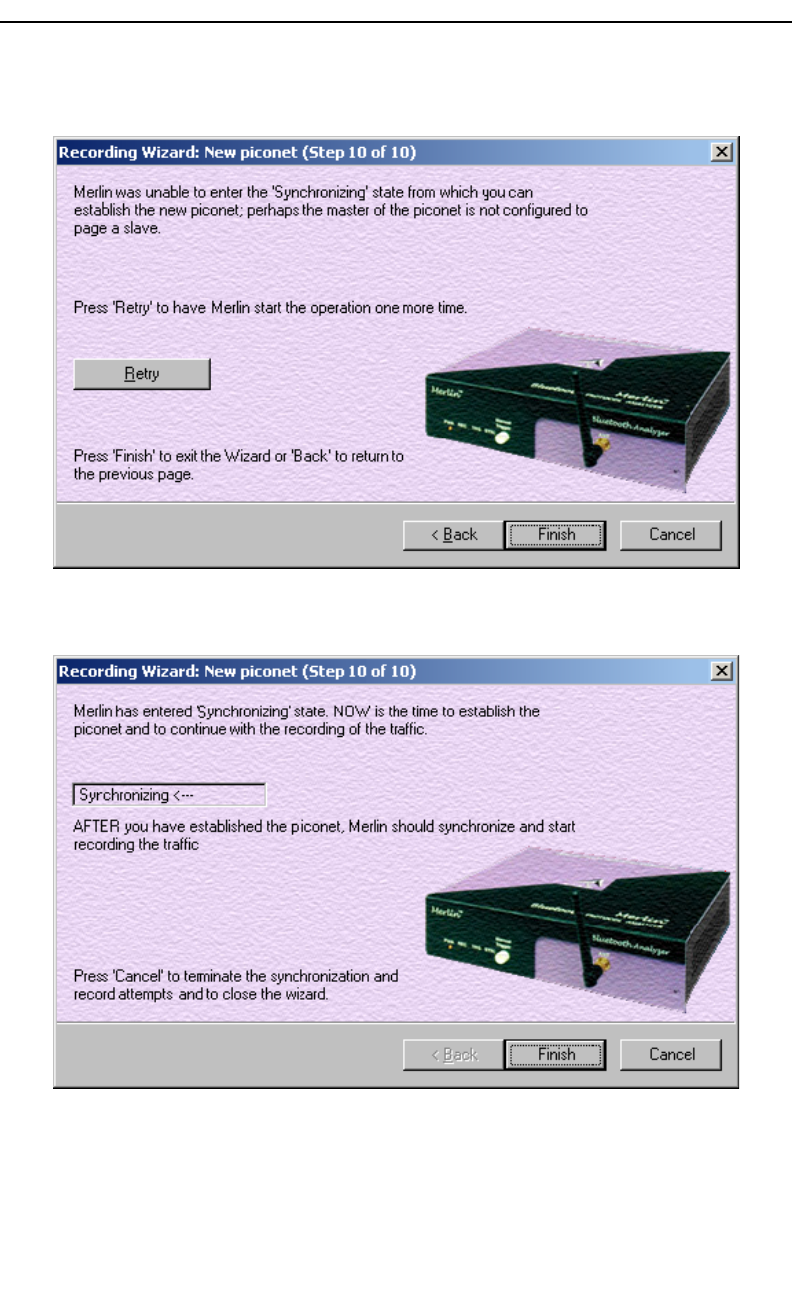
43
Merlin Protocol Analyzer User’s ManualCATC Version 1.6
If Merlin is unable to complete its pages, the following screen will
display:
If Merlin is able to complete its pages, it will enter into a synchronizing
state and then wait for you to create the piconet. During this waiting
period, Merlin will display the following screen:
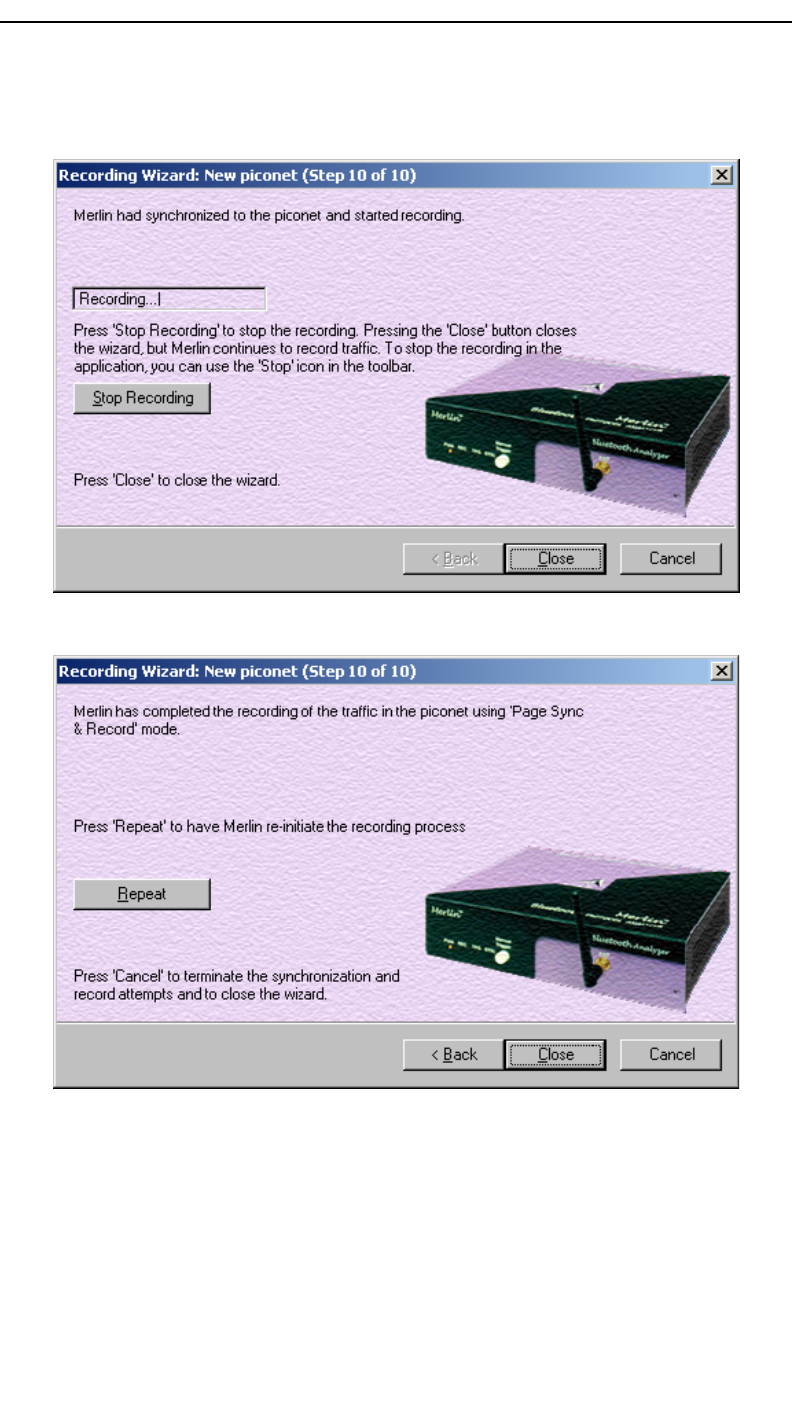
44
Merlin Protocol Analyzer User’s ManualCATC Version 1.6
Once you have created the piconet, Merlin will synchronize to the
piconet and begin recording. During the recording, Merlin will display
the following screen:
At the completion of the recording, Merlin will display the following
screen:
You can repeat the recording by pressing the Repeat button.
Step 15 To close the wizard, press the Close button.